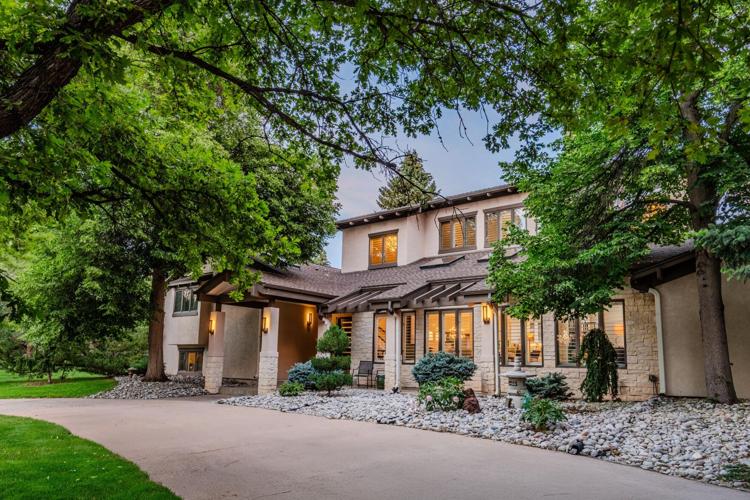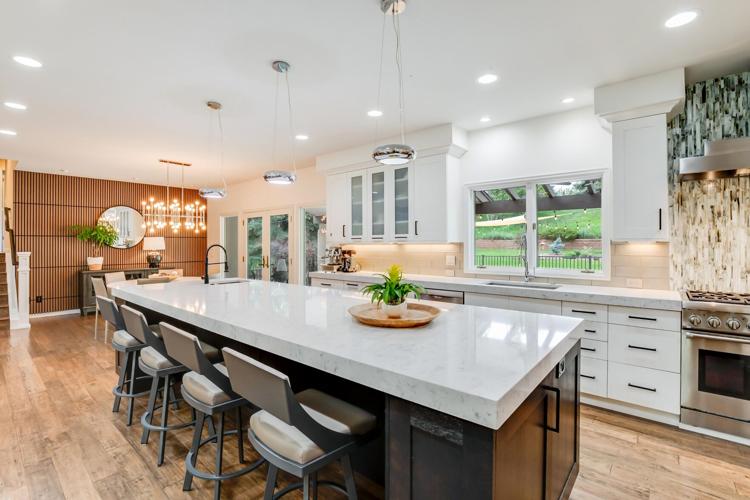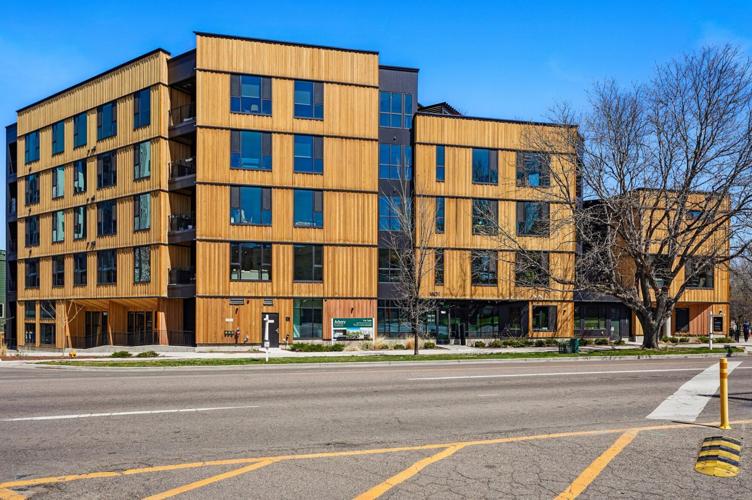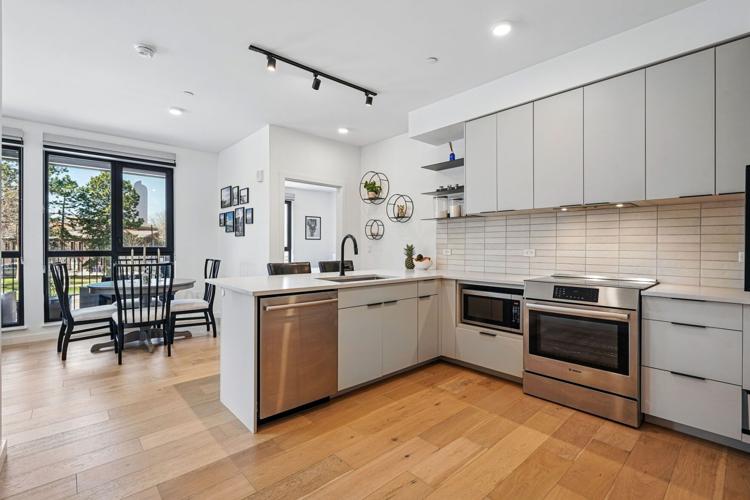Amid summer doldrums, Denver housing market sees prices drop

A home in Greenwood Village that sold over list price last month. “The ones in good shape are getting picked off,” said listing agent Jennifer Markus. Credit Kentwood DTC
Kentwood DTC

A home in Greenwood Village that sold over list price last month. “The ones in good shape are getting picked off,” said listing agent Jennifer Markus. Credit Kentwood DTC
Kentwood DTC
After steady increases in the number of homes for sale in a year when sales haven’t kept pace, the Denver area’s housing market offered up a drop in price last month.
That’s according to a new Metro Real Estate Market Trends Report on the July market issued Tuesday by the Denver Metro Association of Realtors.
According to the report, the median price of a home in the metropolitan area fell to $590,000 last month, down a significant 3.28% from June’s median of $610,000. The new price was 1.67% lower than the price a year ago.
The price drop was true across the board, with single-family homes now selling at a median price of $650,000, down 2.26% from June, and almost identical to the single-family price posted back in July 2024, $655,000.
Condos and other attached homes showed a median price of $390,000, off 2.5% from last month and a full 6% lower than the median a year ago, $415,000.
Falling sales
Meanwhile, total inventory on the market in the Denver metro area stood just short of 14,000 listings, off only marginally from June’s total. The number of actual sales that were completed has fallen, down 16% over the month, and almost 8% over the year.
When inventory rises and sales fail to accelerate, prices tend to drop. But Denver’s market has seen home prices either remaining steady or creeping upward despite the other metrics.
That prompts area agents to wonder whether the new price drop was a summertime fluke.
“It is not unusual to see a seasonal decline in sales volume from June to July as the market shifts into late summer,” said Coldwell Banker agent Amanda Snitker, who chairs DMAR’s Market Trends committee.
But back in midsummer 2024 the median home price had remained flat month-over-month at $655,000, despite sales having fallen from the month before.
Snitker noted that here, as elsewhere, the market could be reflecting a sense of uncertainty that echoes a lack of confidence in the wider consumer environment. Despite the rising number of homes on the market, sales here have dropped around two-and-a-half percent since 2023, Snitker added.
“Three years of sluggish sales are putting pressure on prices as buyers remain hesitant,” Snitker said.
Along with any good news that the marginal price drop portends for Denver area homebuyers, national observers were commenting this week on a drop in interest rates, with the average 30-year rate falling to 6.57%, the lowest in 10 months.
Hopes were also warming that the Federal Reserve might cut its policy rate as early as September, according to researchers at Goldman Sachs. Such a drop could apply some additional downward pressure on mortgage rates.
A segmented market
Local experts contributing to the report commented that the numbers reflect a market that is “highly segmented, with mixed signals — some homes are selling quickly while others sit.”
Across the broader market, agents are now routinely announcing price reductions. That includes at the upper end, where agent Keri Duffy reports for Market Trends on the million-dollar-plus range, showing an inventory that is 25% higher than in midsummer 2024.
“It’s about understanding that you can’t market and price your way out of the public’s uncertain mindset,” Duffy commented for Market Trends. “The buyers who can tune out anxiety and are financially able (still) want the property that makes sense for them today and for their near futures.”
But right now, she added, “that’s a much smaller, much more selective group than in previous months and years.”
Kentwood agent Jennifer Markus, now the top-selling agent in Greenwood Village, told The Gazette that with continuing price increases, the million-dollar-and-up classification has become less meaningful as a marker for luxury homes.
New price definition of luxury
“If you look at Greenwood Village, Cherry Hills and Englewood, it used to be the upper end was $1 million,” said Markus.
Rather, she now focuses on $2.5 million and higher, where even the buyers who arrive with plenty of cash for a down payment may be taking pause as they figure taxes, maintenance and insurance into their calculation.
“$2.5 million is the price that seems to elude a lot of people,” Markus said. “The uptick in prices and inventory is obvious, but the rise and fall of historic sales year-over-year are almost identical.”
“What ends up happening,” she added, “is that if you had 50 homes on the market and 25 of them aren’t updated, the ones that are updated will be the ones flying off the shelf. That’s why you see the same listings that tend to hang on the market.
“Now buyers can pick thru the dreck and pick the good stuff,” Markus added. “The ones in good shape are getting picked off.”
Behind the slower sales pace, she noted, agents were also seeing a larger-than-average number of contracts that fall apart before closing.
Longer selling times
West+Main Homes agent Michelle Schwinghammer, who reports on the mid-upper range of $750,000 to $1 million, notes that completed sales had dropped almost 19% for that price range and were down over 10% from summer 2024.
Potential buyers, she said, had even more to pick from in the attached home market, where despite a rise in sales, the available supply of homes had climbed to five months.
“Higher inventory levels are translating into noticeably longer selling times,” Schwinghammer said.
Even for single-family homes, the average days on the market required for a sale had increase 9% over the month and was up 125% over the past year. “While traditional single-family listings tend to move faster across all price points, they are beginning to stall in this range as well,” she noted.
Agent Andrew Abrams with Guide Real Estate, who reports on the lower ranges of the market, noted that inventory and sales had each climbed over the month in the below-$500,000 range.
Buyer’s market for attached homes
“However, with 5.04 months of inventory, the attached market has officially tilted toward buyers,” Abrams said.
He added that condos, in particular, were facing sales challenges, and speculated that insurance regulations could be adding to buyers’ hesitancy on those products.
“There’s a growing perception that listings simply ‘won’t sell,’” Abrams said about the lower range. The average days on the market in that range had increased from 33 to 40.
“This reflects a change in buyer behavior,” Abrams added. “Today’s buyers want homes that are move-in ready, ample time to do due diligence, and the ability to move at their own pace.”
“As a result of growing inventory and longer time on the market, prices are beginning to adjust,” West+Main’s Schwinghammer added.
A fall in prices, she said, could signal that the Denver market was becoming “unstuck.”
Denver News, Sports & Business | Denver Gazette
With help from two veterans, improvement of Broncos linebacker Levelle Bailey has been ‘night and day’
Chris Tomasson
chris-tomasson@midtc.com
Updated 4 days ago
1 of 2Broncos linebacker Levelle Bailey after training camp practice on Friday, Aug. 1 at Broncos Park in Englewood. (Chris Tomasson/The Denver Gazette)Chris Tomasson chris.tomasson@gazette.com2 of 2Denver Broncos linebacker Levelle Bailey (56) during the second half of an NFL football...
Chris Tomasson
Reporter
Denver News, Sports & Business | Denver Gazette
PHOTOS: Broncos Training Camp Week 2
Stephen Swofford
stephen-swofford@midtc.com
Updated 4 days ago
[inline_gallery image_url=”aHR0cHM6Ly9ibG94aW1hZ2VzLm5ld3lvcmsxLnZpcC50b3dubmV3cy5jb20vZGVudmVyZ2F6ZXR0ZS5jb20vY29udGVudC90bmNtcy9hc3NldHMvdjMvZWRpdG9yaWFsLzEvMzEvMTMxZDkzM2MtNGY5NS00Y2YzLTg4ZmItODRjODhkYzAyOGI3LzY4OGQxY2VjYWZkNDMuaW1hZ2UuanBn” caption_text=”PHNwYW4gY2xhc3M9ImNhcHRpb24tdGV4dCI+CjxwPkJyb25jb3MgVGlnaHQgRW5kIEx1Y2FzIEtydWxsIHdhcm1zIHVwIGJlZm9yZSB0aGUgc3RhcnQgb2YgcHJhY3RpY2UgZHVyaW5nIEJyb25jb3MgdHJhaW5pbmcgY2FtcCBvbiBGcmlkYXksIEF1Zy4gMSwgMjAyNSAoU3RlcGhlbiBTd29mZm9yZCwgRGVudmVyIEdhemV0dGUpPC9wPgo8L3NwYW4+CjxzcGFuIGNsYXNzPSJjcmVkaXQiPgo8c3BhbiBjbGFzcz0idG50LWJ5bGluZSBhc3NldC1ieWxpbmUiIGlkPSJhdXRob3ItODJiNjU3YWEtMTkyNC0xMWVmLWE1MDgtOGJmYzUyMDJmNzEzLWFzc2V0LTEzMWQ5MzNjLTRmOTUtNGNmMy04OGZiLTg0Yzg4ZGMwMjhiNyI+PGEgaHJlZj0iaHR0cHM6Ly9kZW52ZXJnYXpldHRlLmNvbS91c2Vycy9wcm9maWxlL1N0ZXBoZW4lMjBTd29mZm9yZCIgcmVsPSJhdXRob3IiPlN0ZXBoZW4gU3dvZmZvcmQ8L2E+PC9zcGFuPgo8L3NwYW4+CjxzcGFuIGNsYXNzPSJjbGVhcmZpeCI+PC9zcGFuPg==”] [inline_gallery image_url=”aHR0cHM6Ly9ibG94aW1hZ2VzLm5ld3lvcmsxLnZpcC50b3dubmV3cy5jb20vZGVudmVyZ2F6ZXR0ZS5jb20vY29udGVudC90bmNtcy9hc3NldHMvdjMvZWRpdG9yaWFsLzEvMzMvMTMzZGUzOGMtMjRjNy00ODU1LTgwNTMtMmFiOTlhYmQ1N2FkLzY4OGQxY2M5NTlkNGQuaW1hZ2UuanBn” caption_text=”PHNwYW4gY2xhc3M9ImNhcHRpb24tdGV4dCI+CjxwPk5ld2x5IHNpZ25lZCBCcm9uY29zIExpbmViYWNrZXIgR2FycmV0dCBOZWxzb24gc3RyZXRjaGVzIGJlZm9yZSB0aGUgc3RhcnQgb2YgcHJhY3RpY2UgZHVyaW5nIEJyb25jb3MgVHJhaW5pbmcgQ2FtcCBvbiBUaHVyc2RheSwgSnVseSAzMSwgMjAyNS4gKFN0ZXBoZW4gU3dvZmZvcmQsIERlbnZlciBHYXpldHRlKTwvcD4KPC9zcGFuPgo8c3BhbiBjbGFzcz0iY3JlZGl0Ij4KPHNwYW4gY2xhc3M9InRudC1ieWxpbmUgYXNzZXQtYnlsaW5lIiBpZD0iYXV0aG9yLTgyYjY1N2FhLTE5MjQtMTFlZi1hNTA4LThiZmM1MjAyZjcxMy1hc3NldC0xMzNkZTM4Yy0yNGM3LTQ4NTUtODA1My0yYWI5OWFiZDU3YWQiPjxhIGhyZWY9Imh0dHBzOi8vZGVudmVyZ2F6ZXR0ZS5jb20vdXNlcnMvcHJvZmlsZS9TdGVwaGVuJTIwU3dvZmZvcmQiIHJlbD0iYXV0aG9yIj5TdGVwaGVuIFN3b2Zmb3JkPC9hPjwvc3Bhbj4KPC9zcGFuPgo8c3BhbiBjbGFzcz0iY2xlYXJmaXgiPjwvc3Bhbj4=”] [inline_gallery image_url=”aHR0cHM6Ly9ibG94aW1hZ2VzLm5ld3lvcmsxLnZpcC50b3dubmV3cy5jb20vZGVudmVyZ2F6ZXR0ZS5jb20vY29udGVudC90bmNtcy9hc3NldHMvdjMvZWRpdG9yaWFsLzMvOWQvMzlkNTEyY2YtYmQ0ZS00ZWJmLTg2NDItNTU3M2YxMGU4MmVlLzY4OGQxY2ZlNjZmNjcuaW1hZ2UuanBn” caption_text=”PHNwYW4gY2xhc3M9ImNhcHRpb24tdGV4dCI+CjxwPkJyb25jb3MgU2FmZXR5IEJyYW5kb24gSm9uZXMgc3RyZXRjaGVzIGR1cmluZyB3YXJtIHVwcyBhdCBCcm9uY29zIHRyYWluaW5nIGNhbXAgb24gRnJpZGF5LCBBdWcuIDEsIDIwMjUgKFN0ZXBoZW4gU3dvZmZvcmQsIERlbnZlciBHYXpldHRlKTwvcD4KPC9zcGFuPgo8c3BhbiBjbGFzcz0iY3JlZGl0Ij4KPHNwYW4gY2xhc3M9InRudC1ieWxpbmUgYXNzZXQtYnlsaW5lIiBpZD0iYXV0aG9yLTgyYjY1N2FhLTE5MjQtMTFlZi1hNTA4LThiZmM1MjAyZjcxMy1hc3NldC0zOWQ1MTJjZi1iZDRlLTRlYmYtODY0Mi01NTczZjEwZTgyZWUiPjxhIGhyZWY9Imh0dHBzOi8vZGVudmVyZ2F6ZXR0ZS5jb20vdXNlcnMvcHJvZmlsZS9TdGVwaGVuJTIwU3dvZmZvcmQiIHJlbD0iYXV0aG9yIj5TdGVwaGVuIFN3b2Zmb3JkPC9hPjwvc3Bhbj4KPC9zcGFuPgo8c3BhbiBjbGFzcz0iY2xlYXJmaXgiPjwvc3Bhbj4=”] [inline_gallery image_url=”aHR0cHM6Ly9ibG94aW1hZ2VzLm5ld3lvcmsxLnZpcC50b3dubmV3cy5jb20vZGVudmVyZ2F6ZXR0ZS5jb20vY29udGVudC90bmNtcy9hc3NldHMvdjMvZWRpdG9yaWFsLzQvYzMvNGMzNjZkYjMtMGEwNy00NzJlLWJjYTQtMzM4MDBhNDcwMzYwLzY4OGQxZDFiYWZkNGYuaW1hZ2UuanBn” caption_text=”PHNwYW4gY2xhc3M9ImNhcHRpb24tdGV4dCI+CjxwPkJyb25jb3MgU2FmZXR5IFRhbGFub2EgSHVmYW5nYSBwdXRzIG9uIGhpcyBoZWxtZXQgYWZ0ZXIgd2FybSB1cHMgZHVyaW5nIEJyb25jb3MgdHJhaW5pbmcgY2FtcCBvbiBGcmlkYXksIEF1Zy4gMSwgMjAyNSAoU3RlcGhlbiBTd29mZm9yZCwgRGVudmVyIEdhemV0dGUpPC9wPgo8L3NwYW4+CjxzcGFuIGNsYXNzPSJjcmVkaXQiPgo8c3BhbiBjbGFzcz0idG50LWJ5bGluZSBhc3NldC1ieWxpbmUiIGlkPSJhdXRob3ItODJiNjU3YWEtMTkyNC0xMWVmLWE1MDgtOGJmYzUyMDJmNzEzLWFzc2V0LTRjMzY2ZGIzLTBhMDctNDcyZS1iY2E0LTMzODAwYTQ3MDM2MCI+PGEgaHJlZj0iaHR0cHM6Ly9kZW52ZXJnYXpldHRlLmNvbS91c2Vycy9wcm9maWxlL1N0ZXBoZW4lMjBTd29mZm9yZCIgcmVsPSJhdXRob3IiPlN0ZXBoZW4gU3dvZmZvcmQ8L2E+PC9zcGFuPgo8L3NwYW4+CjxzcGFuIGNsYXNzPSJjbGVhcmZpeCI+PC9zcGFuPg==”] [inline_gallery image_url=”aHR0cHM6Ly9ibG94aW1hZ2VzLm5ld3lvcmsxLnZpcC50b3dubmV3cy5jb20vZGVudmVyZ2F6ZXR0ZS5jb20vY29udGVudC90bmNtcy9hc3NldHMvdjMvZWRpdG9yaWFsLzYvMjIvNjIyNmFlYmItZmIxZS00ZTQ4LWFlNjUtOGE1OTdmM2M3NTMyLzY4OGQxY2IxYTlmMmIuaW1hZ2UuanBn” caption_text=”PHNwYW4gY2xhc3M9ImNhcHRpb24tdGV4dCI+CjxwPkJyb25jb3MgV2lkZSBSZWNlaXZlciBLeXJlc2UgV2hpdGUgY2F0Y2hlcyBhIGJhbGwgYXMgaGUgd2FybXMgdXAgYmVmb3JlIHRoZSBzdGFydCBvZiBwcmFjdGljZSBkdXJpbmcgQnJvbmNvcyBUcmFpbmluZyBDYW1wIG9uIFRodXJzZGF5LCBKdWx5IDMxLCAyMDI1IChTdGVwaGVuIFN3b2Zmb3JkLCBEZW52ZXIgR2F6ZXR0ZSk8L3A+Cjwvc3Bhbj4KPHNwYW4gY2xhc3M9ImNyZWRpdCI+CjxzcGFuIGNsYXNzPSJ0bnQtYnlsaW5lIGFzc2V0LWJ5bGluZSIgaWQ9ImF1dGhvci04MmI2NTdhYS0xOTI0LTExZWYtYTUwOC04YmZjNTIwMmY3MTMtYXNzZXQtNjIyNmFlYmItZmIxZS00ZTQ4LWFlNjUtOGE1OTdmM2M3NTMyIj48YSBocmVmPSJodHRwczovL2RlbnZlcmdhemV0dGUuY29tL3VzZXJzL3Byb2ZpbGUvU3RlcGhlbiUyMFN3b2Zmb3JkIiByZWw9ImF1dGhvciI+U3RlcGhlbiBTd29mZm9yZDwvYT48L3NwYW4+Cjwvc3Bhbj4KPHNwYW4gY2xhc3M9ImNsZWFyZml4Ij48L3NwYW4+”] [inline_gallery image_url=”aHR0cHM6Ly9ibG94aW1hZ2VzLm5ld3lvcmsxLnZpcC50b3dubmV3cy5jb20vZGVudmVyZ2F6ZXR0ZS5jb20vY29udGVudC90bmNtcy9hc3NldHMvdjMvZWRpdG9yaWFsLzYvZDEvNmQxNmZlNDUtOTE5MC00ZDg5LTlkOGYtZWU0ZDlhMjNlMjQ0LzY4OGQxZDA5MjkxNDEuaW1hZ2UuanBn” caption_text=”PHNwYW4gY2xhc3M9ImNhcHRpb24tdGV4dCI+CjxwPkJyb25jb3MgV2lkZSBSZWNlaXZlciBUcmVudCBTaGVyZmllbGQgU3IuIG1pc3NlcyBhIGNhdGNoIGR1cmluZyBCcm9uY29zIHRyYWluaW5nIGNhbXAgb24gRnJpZGF5LCBBdWcuIDEsIDIwMjUgKFN0ZXBoZW4gU3dvZmZvcmQsIERlbnZlciBHYXpldHRlKTwvcD4KPC9zcGFuPgo8c3BhbiBjbGFzcz0iY3JlZGl0Ij4KPHNwYW4gY2xhc3M9InRudC1ieWxpbmUgYXNzZXQtYnlsaW5lIiBpZD0iYXV0aG9yLTgyYjY1N2FhLTE5MjQtMTFlZi1hNTA4LThiZmM1MjAyZjcxMy1hc3NldC02ZDE2ZmU0NS05MTkwLTRkODktOWQ4Zi1lZTRkOWEyM2UyNDQiPjxhIGhyZWY9Imh0dHBzOi8vZGVudmVyZ2F6ZXR0ZS5jb20vdXNlcnMvcHJvZmlsZS9TdGVwaGVuJTIwU3dvZmZvcmQiIHJlbD0iYXV0aG9yIj5TdGVwaGVuIFN3b2Zmb3JkPC9hPjwvc3Bhbj4KPC9zcGFuPgo8c3BhbiBjbGFzcz0iY2xlYXJmaXgiPjwvc3Bhbj4=”] [inline_gallery image_url=”aHR0cHM6Ly9ibG94aW1hZ2VzLm5ld3lvcmsxLnZpcC50b3dubmV3cy5jb20vZGVudmVyZ2F6ZXR0ZS5jb20vY29udGVudC90bmNtcy9hc3NldHMvdjMvZWRpdG9yaWFsLzcvOTIvNzkyOGVkNTktZmM3Ny00YjdiLWE2ZmItMjBkYzI4MGQ4YTYyLzY4OGQxY2YxZDA0ZGMuaW1hZ2UuanBn” caption_text=”PHNwYW4gY2xhc3M9ImNhcHRpb24tdGV4dCI+CjxwPkJyb25jb3MgSW5zaWRlIExpbmViYWNrZXIgSnVzdGluIFN0cm5hZCBzdHJldGNoZXMgZHVyaW5nIHdhcm0gdXBzIGF0IEJyb25jb3MgdHJhaW5pbmcgY2FtcCBvbiBGcmlkYXksIEF1Zy4gMSwgMjAyNSAoU3RlcGhlbiBTd29mZm9yZCwgRGVudmVyIEdhemV0dGUpPC9wPgo8L3NwYW4+CjxzcGFuIGNsYXNzPSJjcmVkaXQiPgo8c3BhbiBjbGFzcz0idG50LWJ5bGluZSBhc3NldC1ieWxpbmUiIGlkPSJhdXRob3ItODJiNjU3YWEtMTkyNC0xMWVmLWE1MDgtOGJmYzUyMDJmNzEzLWFzc2V0LTc5MjhlZDU5LWZjNzctNGI3Yi1hNmZiLTIwZGMyODBkOGE2MiI+PGEgaHJlZj0iaHR0cHM6Ly9kZW52ZXJnYXpldHRlLmNvbS91c2Vycy9wcm9maWxlL1N0ZXBoZW4lMjBTd29mZm9yZCIgcmVsPSJhdXRob3IiPlN0ZXBoZW4gU3dvZmZvcmQ8L2E+PC9zcGFuPgo8L3NwYW4+CjxzcGFuIGNsYXNzPSJjbGVhcmZpeCI+PC9zcGFuPg==”] [inline_gallery image_url=”aHR0cHM6Ly9ibG94aW1hZ2VzLm5ld3lvcmsxLnZpcC50b3dubmV3cy5jb20vZGVudmVyZ2F6ZXR0ZS5jb20vY29udGVudC90bmNtcy9hc3NldHMvdjMvZWRpdG9yaWFsLzcvYjcvN2I3YjA0NTItNGEzNC00NzNjLTkwNDItZDA4MmNhYzUwYTgwLzY4OGQxZDNjMTIzNWMuaW1hZ2UuanBn” caption_text=”PHNwYW4gY2xhc3M9ImNhcHRpb24tdGV4dCI+CjxwPkJyb25jb3MgTGluZWJhY2tlciBEcmUgR3JlZW5sYXcgcnVucyBkcmlsbHMgZHVyaW5nIEJyb25jb3MgdHJhaW5pbmcgY2FtcCBvbiBGcmlkYXksIEF1Zy4gMSwgMjAyNSAoU3RlcGhlbiBTd29mZm9yZCwgRGVudmVyIEdhemV0dGUpPC9wPgo8L3NwYW4+CjxzcGFuIGNsYXNzPSJjcmVkaXQiPgo8c3BhbiBjbGFzcz0idG50LWJ5bGluZSBhc3NldC1ieWxpbmUiIGlkPSJhdXRob3ItODJiNjU3YWEtMTkyNC0xMWVmLWE1MDgtOGJmYzUyMDJmNzEzLWFzc2V0LTdiN2IwNDUyLTRhMzQtNDczYy05MDQyLWQwODJjYWM1MGE4MCI+PGEgaHJlZj0iaHR0cHM6Ly9kZW52ZXJnYXpldHRlLmNvbS91c2Vycy9wcm9maWxlL1N0ZXBoZW4lMjBTd29mZm9yZCIgcmVsPSJhdXRob3IiPlN0ZXBoZW4gU3dvZmZvcmQ8L2E+PC9zcGFuPgo8L3NwYW4+CjxzcGFuIGNsYXNzPSJjbGVhcmZpeCI+PC9zcGFuPg==”] [inline_gallery image_url=”aHR0cHM6Ly9ibG94aW1hZ2VzLm5ld3lvcmsxLnZpcC50b3dubmV3cy5jb20vZGVudmVyZ2F6ZXR0ZS5jb20vY29udGVudC90bmNtcy9hc3NldHMvdjMvZWRpdG9yaWFsLzkvOTAvOTkwMGY5NmItYTYxYy00NGM4LWFhMDQtZDUzMjZhMGNlMDcxLzY4OGQxY2Y4YzVhZGIuaW1hZ2UuanBn” caption_text=”PHNwYW4gY2xhc3M9ImNhcHRpb24tdGV4dCI+CjxwPkJyb25jb3MgRGVmZW5zaXZlIFRhY2tsZSBLcmlzdGlhbiBXaWxsaWFtcyBoeXBlcyB1cCB0aGUgY3Jvd2QgZHVyaW5nIEJyb25jb3MgdHJhaW5pbmcgY2FtcCBvbiBGcmlkYXksIEF1Zy4gMSwgMjAyNSAoU3RlcGhlbiBTd29mZm9yZCwgRGVudmVyIEdhemV0dGUpPC9wPgo8L3NwYW4+CjxzcGFuIGNsYXNzPSJjcmVkaXQiPgo8c3BhbiBjbGFzcz0idG50LWJ5bGluZSBhc3NldC1ieWxpbmUiIGlkPSJhdXRob3ItODJiNjU3YWEtMTkyNC0xMWVmLWE1MDgtOGJmYzUyMDJmNzEzLWFzc2V0LTk5MDBmOTZiLWE2MWMtNDRjOC1hYTA0LWQ1MzI2YTBjZTA3MSI+PGEgaHJlZj0iaHR0cHM6Ly9kZW52ZXJnYXpldHRlLmNvbS91c2Vycy9wcm9maWxlL1N0ZXBoZW4lMjBTd29mZm9yZCIgcmVsPSJhdXRob3IiPlN0ZXBoZW4gU3dvZmZvcmQ8L2E+PC9zcGFuPgo8L3NwYW4+CjxzcGFuIGNsYXNzPSJjbGVhcmZpeCI+PC9zcGFuPg==”] [inline_gallery image_url=”aHR0cHM6Ly9ibG94aW1hZ2VzLm5ld3lvcmsxLnZpcC50b3dubmV3cy5jb20vZGVudmVyZ2F6ZXR0ZS5jb20vY29udGVudC90bmNtcy9hc3NldHMvdjMvZWRpdG9yaWFsLzkvYzQvOWM0NTUzMjEtZGMyZS00YTQwLTlhYjktZjZlOGQ3ZDJiZDhjLzY4OGQxZDA0NDA2MzguaW1hZ2UuanBn” caption_text=”PHNwYW4gY2xhc3M9ImNhcHRpb24tdGV4dCI+CjxwPkJyb25jb3MgT2ZmZW5zaXZlIExpbmViYWNrZXIgTmlrIEJvbml0dG8gcnVucyBkcmlsbHMgZHVyaW5nIEJyb25jb3MgdHJhaW5pbmcgY2FtcCBvbiBGcmlkYXksIEF1Zy4gMSwgMjAyNSAoU3RlcGhlbiBTd29mZm9yZCwgRGVudmVyIEdhemV0dGUpPC9wPgo8L3NwYW4+CjxzcGFuIGNsYXNzPSJjcmVkaXQiPgo8c3BhbiBjbGFzcz0idG50LWJ5bGluZSBhc3NldC1ieWxpbmUiIGlkPSJhdXRob3ItODJiNjU3YWEtMTkyNC0xMWVmLWE1MDgtOGJmYzUyMDJmNzEzLWFzc2V0LTljNDU1MzIxLWRjMmUtNGE0MC05YWI5LWY2ZThkN2QyYmQ4YyI+PGEgaHJlZj0iaHR0cHM6Ly9kZW52ZXJnYXpldHRlLmNvbS91c2Vycy9wcm9maWxlL1N0ZXBoZW4lMjBTd29mZm9yZCIgcmVsPSJhdXRob3IiPlN0ZXBoZW4gU3dvZmZvcmQ8L2E+PC9zcGFuPgo8L3NwYW4+CjxzcGFuIGNsYXNzPSJjbGVhcmZpeCI+PC9zcGFuPg==”] [inline_gallery image_url=”aHR0cHM6Ly9ibG94aW1hZ2VzLm5ld3lvcmsxLnZpcC50b3dubmV3cy5jb20vZGVudmVyZ2F6ZXR0ZS5jb20vY29udGVudC90bmNtcy9hc3NldHMvdjMvZWRpdG9yaWFsL2EvMDYvYTA2MTdiMDAtODFhZi00YmIxLWE3MjUtMGNjNmZmMWEyZmE4LzY4OGQxZDM3Mzc3ODIuaW1hZ2UuanBn” caption_text=”PHNwYW4gY2xhc3M9ImNhcHRpb24tdGV4dCI+CjxwPkJyb25jb3MgRGVmZW5zaXZlIGxpbmVtYW4gRXlpb21hIFV3YXp1cmlrZSBydW5zIGRyaWxscyBkdXJpbmcgQnJvbmNvcyB0cmFpbmluZyBjYW1wIG9uIEZyaWRheSwgQXVnLiAxLCAyMDI1IChTdGVwaGVuIFN3b2Zmb3JkLCBEZW52ZXIgR2F6ZXR0ZSk8L3A+Cjwvc3Bhbj4KPHNwYW4gY2xhc3M9ImNyZWRpdCI+CjxzcGFuIGNsYXNzPSJ0bnQtYnlsaW5lIGFzc2V0LWJ5bGluZSIgaWQ9ImF1dGhvci04MmI2NTdhYS0xOTI0LTExZWYtYTUwOC04YmZjNTIwMmY3MTMtYXNzZXQtYTA2MTdiMDAtODFhZi00YmIxLWE3MjUtMGNjNmZmMWEyZmE4Ij48YSBocmVmPSJodHRwczovL2RlbnZlcmdhemV0dGUuY29tL3VzZXJzL3Byb2ZpbGUvU3RlcGhlbiUyMFN3b2Zmb3JkIiByZWw9ImF1dGhvciI+U3RlcGhlbiBTd29mZm9yZDwvYT48L3NwYW4+Cjwvc3Bhbj4KPHNwYW4gY2xhc3M9ImNsZWFyZml4Ij48L3NwYW4+”] [inline_gallery image_url=”aHR0cHM6Ly9ibG94aW1hZ2VzLm5ld3lvcmsxLnZpcC50b3dubmV3cy5jb20vZGVudmVyZ2F6ZXR0ZS5jb20vY29udGVudC90bmNtcy9hc3NldHMvdjMvZWRpdG9yaWFsL2EvYjQvYWI0MzFhMTktNGNkZi00ZTEyLTlkMTUtZGYwMmZkZDMwMjJmLzY4OGQxY2FlNTY0Y2UuaW1hZ2UuanBn” caption_text=”PHNwYW4gY2xhc3M9ImNhcHRpb24tdGV4dCI+CjxwPkNvbnN0cnVjdGlvbiBjcmV3cyBsb3dlciB0aGUgbGFzdCByb29mIHBhbmVsIGludG8gcGxhY2Ugb24gdGhlIG5ldyBicm9uY29zIHRyYWluaW5nIGZhY2lsaXR5IGR1cmluZyBhIGNlcmVtb255IG9uIEZyaWRheSwgQXVnLiAxLCAyMDI1IChTdGVwaGVuIFN3b2Zmb3JkLCBEZW52ZXIgR2F6ZXR0ZSk8L3A+Cjwvc3Bhbj4KPHNwYW4gY2xhc3M9ImNyZWRpdCI+CjxzcGFuIGNsYXNzPSJ0bnQtYnlsaW5lIGFzc2V0LWJ5bGluZSIgaWQ9ImF1dGhvci04MmI2NTdhYS0xOTI0LTExZWYtYTUwOC04YmZjNTIwMmY3MTMtYXNzZXQtYWI0MzFhMTktNGNkZi00ZTEyLTlkMTUtZGYwMmZkZDMwMjJmIj48YSBocmVmPSJodHRwczovL2RlbnZlcmdhemV0dGUuY29tL3VzZXJzL3Byb2ZpbGUvU3RlcGhlbiUyMFN3b2Zmb3JkIiByZWw9ImF1dGhvciI+U3RlcGhlbiBTd29mZm9yZDwvYT48L3NwYW4+Cjwvc3Bhbj4KPHNwYW4gY2xhc3M9ImNsZWFyZml4Ij48L3NwYW4+”] [inline_gallery image_url=”aHR0cHM6Ly9ibG94aW1hZ2VzLm5ld3lvcmsxLnZpcC50b3dubmV3cy5jb20vZGVudmVyZ2F6ZXR0ZS5jb20vY29udGVudC90bmNtcy9hc3NldHMvdjMvZWRpdG9yaWFsL2QvZTUvZGU1Y2Y1ODEtMTgwMy00YWRjLTkyODEtMzRhMTM1MGFjODU0LzY4OGQxZDE2N2IxNGQuaW1hZ2UuanBn” caption_text=”PHNwYW4gY2xhc3M9ImNhcHRpb24tdGV4dCI+CjxwPkJyb25jb3MgQ2VudGVyIEx1a2UgV2F0dGVuYmVyZywgbGVmdCwgYW5kIEd1YXJkIENsYXkgV2ViYiBydW4gYSBkcmlsbCBkdXJpbmcgQnJvbmNvcyB0cmFpbmluZyBjYW1wIG9uIEZyaWRheSwgQXVnLiAxLCAyMDI1IChTdGVwaGVuIFN3b2Zmb3JkLCBEZW52ZXIgR2F6ZXR0ZSk8L3A+Cjwvc3Bhbj4KPHNwYW4gY2xhc3M9ImNyZWRpdCI+CjxzcGFuIGNsYXNzPSJ0bnQtYnlsaW5lIGFzc2V0LWJ5bGluZSIgaWQ9ImF1dGhvci04MmI2NTdhYS0xOTI0LTExZWYtYTUwOC04YmZjNTIwMmY3MTMtYXNzZXQtZGU1Y2Y1ODEtMTgwMy00YWRjLTkyODEtMzRhMTM1MGFjODU0Ij48YSBocmVmPSJodHRwczovL2RlbnZlcmdhemV0dGUuY29tL3VzZXJzL3Byb2ZpbGUvU3RlcGhlbiUyMFN3b2Zmb3JkIiByZWw9ImF1dGhvciI+U3RlcGhlbiBTd29mZm9yZDwvYT48L3NwYW4+Cjwvc3Bhbj4KPHNwYW4gY2xhc3M9ImNsZWFyZml4Ij48L3NwYW4+”] [inline_gallery...
Stephen Swofford
Reporter
Denver News, Sports & Business | Denver Gazette
PHOTOS: Broncos invite fans to the stands for Training Camp
Stephen Swofford
stephen-swofford@midtc.com
Updated 2 weeks ago
[inline_gallery image_url=”aHR0cHM6Ly9ibG94aW1hZ2VzLm5ld3lvcmsxLnZpcC50b3dubmV3cy5jb20vZGVudmVyZ2F6ZXR0ZS5jb20vY29udGVudC90bmNtcy9hc3NldHMvdjMvZWRpdG9yaWFsLzQvYmUvNGJlNGRiMjMtMGNiMy00MDBiLTg1MGUtMGFjY2JmOGU1M2MzLzY4ODNmMDQ3NDk2YmEuaW1hZ2UuanBn” caption_text=”PHNwYW4gY2xhc3M9ImNhcHRpb24tdGV4dCI+CjxwPkJyb25jb3MgRGVmZW5zaXZlIFRhY2tsZSBLcmlzdGlhbiBXaWxsaWFtcyB0YWxrcyB3aXRoIGZhbnMgYXMgaGUgYXV0b2dyYXBocyBtZW1vcmFiaWxpYSBhZnRlciBwcmFjdGljZSBkdXJpbmcgdHJhaW5pbmcgY2FtcCBvbiBGcmlkYXksIEp1bHkgMjUsIDIwMjUuIChTdGVwaGVuIFN3b2Zmb3JkLCBEZW52ZXIgR2F6ZXR0ZSk8L3A+Cjwvc3Bhbj4KPHNwYW4gY2xhc3M9ImNyZWRpdCI+CjxzcGFuIGNsYXNzPSJ0bnQtYnlsaW5lIGFzc2V0LWJ5bGluZSIgaWQ9ImF1dGhvci04MmI2NTdhYS0xOTI0LTExZWYtYTUwOC04YmZjNTIwMmY3MTMtYXNzZXQtNGJlNGRiMjMtMGNiMy00MDBiLTg1MGUtMGFjY2JmOGU1M2MzIj48YSBocmVmPSJodHRwczovL2RlbnZlcmdhemV0dGUuY29tL3VzZXJzL3Byb2ZpbGUvU3RlcGhlbiUyMFN3b2Zmb3JkIiByZWw9ImF1dGhvciI+U3RlcGhlbiBTd29mZm9yZDwvYT48L3NwYW4+Cjwvc3Bhbj4KPHNwYW4gY2xhc3M9ImNsZWFyZml4Ij48L3NwYW4+”] [inline_gallery image_url=”aHR0cHM6Ly9ibG94aW1hZ2VzLm5ld3lvcmsxLnZpcC50b3dubmV3cy5jb20vZGVudmVyZ2F6ZXR0ZS5jb20vY29udGVudC90bmNtcy9hc3NldHMvdjMvZWRpdG9yaWFsLzUvNjAvNTYwNTZlZjQtNzI1Ni00NjIzLWFmZmQtNmY2NjY2ZmMyMGEwLzY4ODNmMDZkYTBkOGQuaW1hZ2UuanBn” caption_text=”PHNwYW4gY2xhc3M9ImNhcHRpb24tdGV4dCI+CjxwPkJyb25jb3MgUnVubmluZ2JhY2sgSmFsZWVsIE1jTGF1Z2hsaW4gY2F0Y2hlcyB0aGUgYmFsbCBhcyBoZSBydW5zIGRyaWxscyBkdXJpbmcgdHJhaW5pbmcgY2FtcCBvbiBGcmlkYXksIEp1bHkgMjUsIDIwMjUuIChTdGVwaGVuIFN3b2Zmb3JkLCBEZW52ZXIgR2F6ZXR0ZSk8L3A+Cjwvc3Bhbj4KPHNwYW4gY2xhc3M9ImNyZWRpdCI+CjxzcGFuIGNsYXNzPSJ0bnQtYnlsaW5lIGFzc2V0LWJ5bGluZSIgaWQ9ImF1dGhvci04MmI2NTdhYS0xOTI0LTExZWYtYTUwOC04YmZjNTIwMmY3MTMtYXNzZXQtNTYwNTZlZjQtNzI1Ni00NjIzLWFmZmQtNmY2NjY2ZmMyMGEwIj48YSBocmVmPSJodHRwczovL2RlbnZlcmdhemV0dGUuY29tL3VzZXJzL3Byb2ZpbGUvU3RlcGhlbiUyMFN3b2Zmb3JkIiByZWw9ImF1dGhvciI+U3RlcGhlbiBTd29mZm9yZDwvYT48L3NwYW4+Cjwvc3Bhbj4KPHNwYW4gY2xhc3M9ImNsZWFyZml4Ij48L3NwYW4+”] [inline_gallery image_url=”aHR0cHM6Ly9ibG94aW1hZ2VzLm5ld3lvcmsxLnZpcC50b3dubmV3cy5jb20vZGVudmVyZ2F6ZXR0ZS5jb20vY29udGVudC90bmNtcy9hc3NldHMvdjMvZWRpdG9yaWFsLzEvMjQvMTI0NTVlMTMtMmVkYi00OTgxLTg0MmYtMWZiM2UxNmM0MmE1LzY4ODNmMDdiNDFjNzguaW1hZ2UuanBn” caption_text=”PHNwYW4gY2xhc3M9ImNhcHRpb24tdGV4dCI+CjxwPkJyb25jb3MgUXVhcnRlcmJhY2sgQm8gTml4IHdhcm1zIHVwIHdpdGggdGhlIHRlYW0gZHVyaW5nIHRyYWluaW5nIGNhbXAgb24gRnJpZGF5LCBKdWx5IDI1LCAyMDI1LiAoU3RlcGhlbiBTd29mZm9yZCwgRGVudmVyIEdhemV0dGUpPC9wPgo8L3NwYW4+CjxzcGFuIGNsYXNzPSJjcmVkaXQiPgo8c3BhbiBjbGFzcz0idG50LWJ5bGluZSBhc3NldC1ieWxpbmUiIGlkPSJhdXRob3ItODJiNjU3YWEtMTkyNC0xMWVmLWE1MDgtOGJmYzUyMDJmNzEzLWFzc2V0LTEyNDU1ZTEzLTJlZGItNDk4MS04NDJmLTFmYjNlMTZjNDJhNSI+PGEgaHJlZj0iaHR0cHM6Ly9kZW52ZXJnYXpldHRlLmNvbS91c2Vycy9wcm9maWxlL1N0ZXBoZW4lMjBTd29mZm9yZCIgcmVsPSJhdXRob3IiPlN0ZXBoZW4gU3dvZmZvcmQ8L2E+PC9zcGFuPgo8L3NwYW4+CjxzcGFuIGNsYXNzPSJjbGVhcmZpeCI+PC9zcGFuPg==”] [inline_gallery image_url=”aHR0cHM6Ly9ibG94aW1hZ2VzLm5ld3lvcmsxLnZpcC50b3dubmV3cy5jb20vZGVudmVyZ2F6ZXR0ZS5jb20vY29udGVudC90bmNtcy9hc3NldHMvdjMvZWRpdG9yaWFsLzEvY2UvMWNlNzQ1ZTUtY2RhOS00YmRhLTgzMzgtZTg5MzA2MjQ4YzQ0LzY4ODNmMGEwZDYxZGYuaW1hZ2UuanBn” caption_text=”PHNwYW4gY2xhc3M9ImNhcHRpb24tdGV4dCI+CjxwPkJyb25jb3MgV2lkZSBSZWNlaXZlciBNYXJ2aW4gTWltcyBKci4gY2F0Y2hlcyB0aGUgYmFsbCBkdXJpbmcgYSBkcmlsbCBhdCBUcmFpbmluZyBDYW1wIG9uIEZyaWRheSwgSnVseSAyNSwgMjAyNS4gKFN0ZXBoZW4gU3dvZmZvcmQsIERlbnZlciBHYXpldHRlKTwvcD4KPC9zcGFuPgo8c3BhbiBjbGFzcz0iY3JlZGl0Ij4KPHNwYW4gY2xhc3M9InRudC1ieWxpbmUgYXNzZXQtYnlsaW5lIiBpZD0iYXV0aG9yLTgyYjY1N2FhLTE5MjQtMTFlZi1hNTA4LThiZmM1MjAyZjcxMy1hc3NldC0xY2U3NDVlNS1jZGE5LTRiZGEtODMzOC1lODkzMDYyNDhjNDQiPjxhIGhyZWY9Imh0dHBzOi8vZGVudmVyZ2F6ZXR0ZS5jb20vdXNlcnMvcHJvZmlsZS9TdGVwaGVuJTIwU3dvZmZvcmQiIHJlbD0iYXV0aG9yIj5TdGVwaGVuIFN3b2Zmb3JkPC9hPjwvc3Bhbj4KPC9zcGFuPgo8c3BhbiBjbGFzcz0iY2xlYXJmaXgiPjwvc3Bhbj4=”] [inline_gallery image_url=”aHR0cHM6Ly9ibG94aW1hZ2VzLm5ld3lvcmsxLnZpcC50b3dubmV3cy5jb20vZGVudmVyZ2F6ZXR0ZS5jb20vY29udGVudC90bmNtcy9hc3NldHMvdjMvZWRpdG9yaWFsLzIvMDcvMjA3ZmU2NjQtMzdmMy00M2FmLTk2ZmQtZTFlY2M0OWNkZTgzLzY4ODNmMDlhNmQyMTcuaW1hZ2UuanBn” caption_text=”PHNwYW4gY2xhc3M9ImNhcHRpb24tdGV4dCI+CjxwPkJyb25jb3MgRGVmZW5zaXZlIExpbmVtYW4gWmFjaCBBbGxlbiB3YXJtcyB1cCB3aXRoIHRoZSB0ZWFtIGR1cmluZyB0cmFpbmluZyBjYW1wIG9uIEZyaWRheSwgSnVseSAyNSwgMjAyNS4gKFN0ZXBoZW4gU3dvZmZvcmQsIERlbnZlciBHYXpldHRlKTwvcD4KPC9zcGFuPgo8c3BhbiBjbGFzcz0iY3JlZGl0Ij4KPHNwYW4gY2xhc3M9InRudC1ieWxpbmUgYXNzZXQtYnlsaW5lIiBpZD0iYXV0aG9yLTgyYjY1N2FhLTE5MjQtMTFlZi1hNTA4LThiZmM1MjAyZjcxMy1hc3NldC0yMDdmZTY2NC0zN2YzLTQzYWYtOTZmZC1lMWVjYzQ5Y2RlODMiPjxhIGhyZWY9Imh0dHBzOi8vZGVudmVyZ2F6ZXR0ZS5jb20vdXNlcnMvcHJvZmlsZS9TdGVwaGVuJTIwU3dvZmZvcmQiIHJlbD0iYXV0aG9yIj5TdGVwaGVuIFN3b2Zmb3JkPC9hPjwvc3Bhbj4KPC9zcGFuPgo8c3BhbiBjbGFzcz0iY2xlYXJmaXgiPjwvc3Bhbj4=”] [inline_gallery image_url=”aHR0cHM6Ly9ibG94aW1hZ2VzLm5ld3lvcmsxLnZpcC50b3dubmV3cy5jb20vZGVudmVyZ2F6ZXR0ZS5jb20vY29udGVudC90bmNtcy9hc3NldHMvdjMvZWRpdG9yaWFsLzUvODgvNTg4MTBjZGEtZDQ0My00MDE1LTg0MzgtOTEyODRmZTQ2OTEzLzY4ODNmMDYyOGVjYmQuaW1hZ2UuanBn” caption_text=”PHNwYW4gY2xhc3M9ImNhcHRpb24tdGV4dCI+CjxwPkJyb25jb3MgV2lkZSBSZWNlaXZlciBDb3VydGxhbmQgU3V0dG9uIGNhdGNoZXMgYSBiYWxsIGFzIGhlIHdhcm1zIHVwIGJlZm9yZSB0cmFpbmluZyBjYW1wIG9uIEZyaWRheSwgSnVseSAyNSwgMjAyNS4gKFN0ZXBoZW4gU3dvZmZvcmQsIERlbnZlciBHYXpldHRlKTwvcD4KPC9zcGFuPgo8c3BhbiBjbGFzcz0iY3JlZGl0Ij4KPHNwYW4gY2xhc3M9InRudC1ieWxpbmUgYXNzZXQtYnlsaW5lIiBpZD0iYXV0aG9yLTgyYjY1N2FhLTE5MjQtMTFlZi1hNTA4LThiZmM1MjAyZjcxMy1hc3NldC01ODgxMGNkYS1kNDQzLTQwMTUtODQzOC05MTI4NGZlNDY5MTMiPjxhIGhyZWY9Imh0dHBzOi8vZGVudmVyZ2F6ZXR0ZS5jb20vdXNlcnMvcHJvZmlsZS9TdGVwaGVuJTIwU3dvZmZvcmQiIHJlbD0iYXV0aG9yIj5TdGVwaGVuIFN3b2Zmb3JkPC9hPjwvc3Bhbj4KPC9zcGFuPgo8c3BhbiBjbGFzcz0iY2xlYXJmaXgiPjwvc3Bhbj4=”] [inline_gallery image_url=”aHR0cHM6Ly9ibG94aW1hZ2VzLm5ld3lvcmsxLnZpcC50b3dubmV3cy5jb20vZGVudmVyZ2F6ZXR0ZS5jb20vY29udGVudC90bmNtcy9hc3NldHMvdjMvZWRpdG9yaWFsLzUvOTIvNTkyZDQ4NGUtYTk3Ny00ZjYyLTkyMWQtYzg4M2I0OTRlYjkwLzY4ODNmMDY5ZGIxODIuaW1hZ2UuanBn” caption_text=”PHNwYW4gY2xhc3M9ImNhcHRpb24tdGV4dCI+CjxwPkJyb25jb3MgaGVhZCBjb2FjaCBTZWFuIFBheXRvbiB3YXRjaGVzIHBsYXllcnMgcnVuIGEgZHJpbGwgZHVyaW5nIHRyYWluaW5nIGNhbXAgb24gRnJpZGF5LCBKdWx5IDI1LCAyMDI1LiAoU3RlcGhlbiBTd29mZm9yZCwgRGVudmVyIEdhemV0dGUpPC9wPgo8L3NwYW4+CjxzcGFuIGNsYXNzPSJjcmVkaXQiPgo8c3BhbiBjbGFzcz0idG50LWJ5bGluZSBhc3NldC1ieWxpbmUiIGlkPSJhdXRob3ItODJiNjU3YWEtMTkyNC0xMWVmLWE1MDgtOGJmYzUyMDJmNzEzLWFzc2V0LTU5MmQ0ODRlLWE5NzctNGY2Mi05MjFkLWM4ODNiNDk0ZWI5MCI+PGEgaHJlZj0iaHR0cHM6Ly9kZW52ZXJnYXpldHRlLmNvbS91c2Vycy9wcm9maWxlL1N0ZXBoZW4lMjBTd29mZm9yZCIgcmVsPSJhdXRob3IiPlN0ZXBoZW4gU3dvZmZvcmQ8L2E+PC9zcGFuPgo8L3NwYW4+CjxzcGFuIGNsYXNzPSJjbGVhcmZpeCI+PC9zcGFuPg==”] [inline_gallery image_url=”aHR0cHM6Ly9ibG94aW1hZ2VzLm5ld3lvcmsxLnZpcC50b3dubmV3cy5jb20vZGVudmVyZ2F6ZXR0ZS5jb20vY29udGVudC90bmNtcy9hc3NldHMvdjMvZWRpdG9yaWFsLzUvY2IvNWNiYjk1NmYtYzQwNi00ZjEwLTk0M2ItM2Q5ZWM5NDk0NzA3LzY4ODNmMDg5OTM1MzkuaW1hZ2UuanBn” caption_text=”PHNwYW4gY2xhc3M9ImNhcHRpb24tdGV4dCI+CjxwPkJyb25jb3MgUnVubmluZ2JhY2sgSmFsZWVsIE1jTGF1Z2hsaW4gd2FybXMgdXAgYWdhaW5zdCB0aGUgc2lkZSBvZiBhIGJ1aWxkaW5nIGJlZm9yZSB0aGUgc3RhcnQgb2YgdHJhaW5pbmcgY2FtcCBvbiBGcmlkYXksIEp1bHkgMjUsIDIwMjUuIChTdGVwaGVuIFN3b2Zmb3JkLCBEZW52ZXIgR2F6ZXR0ZSk8L3A+Cjwvc3Bhbj4KPHNwYW4gY2xhc3M9ImNyZWRpdCI+CjxzcGFuIGNsYXNzPSJ0bnQtYnlsaW5lIGFzc2V0LWJ5bGluZSIgaWQ9ImF1dGhvci04MmI2NTdhYS0xOTI0LTExZWYtYTUwOC04YmZjNTIwMmY3MTMtYXNzZXQtNWNiYjk1NmYtYzQwNi00ZjEwLTk0M2ItM2Q5ZWM5NDk0NzA3Ij48YSBocmVmPSJodHRwczovL2RlbnZlcmdhemV0dGUuY29tL3VzZXJzL3Byb2ZpbGUvU3RlcGhlbiUyMFN3b2Zmb3JkIiByZWw9ImF1dGhvciI+U3RlcGhlbiBTd29mZm9yZDwvYT48L3NwYW4+Cjwvc3Bhbj4KPHNwYW4gY2xhc3M9ImNsZWFyZml4Ij48L3NwYW4+”] [inline_gallery image_url=”aHR0cHM6Ly9ibG94aW1hZ2VzLm5ld3lvcmsxLnZpcC50b3dubmV3cy5jb20vZGVudmVyZ2F6ZXR0ZS5jb20vY29udGVudC90bmNtcy9hc3NldHMvdjMvZWRpdG9yaWFsLzcvODcvNzg3OTZjODItMzM3NC00NjRmLTllNzgtYmI3ZmZhODAyNTI4LzY4ODNmMDc2NjRjMzguaW1hZ2UuanBn” caption_text=”PHNwYW4gY2xhc3M9ImNhcHRpb24tdGV4dCI+CjxwPkJyb25jb3MgQ2VudGVyYmFjayBQYXQgU3VydGFpbiBJSSB3YXJtcyB1cCB3aXRoIHRoZSB0ZWFtIGR1cmluZyB0cmFpbmluZyBjYW1wIG9uIEZyaWRheSwgSnVseSAyNSwgMjAyNS4gKFN0ZXBoZW4gU3dvZmZvcmQsIERlbnZlciBHYXpldHRlKTwvcD4KPC9zcGFuPgo8c3BhbiBjbGFzcz0iY3JlZGl0Ij4KPHNwYW4gY2xhc3M9InRudC1ieWxpbmUgYXNzZXQtYnlsaW5lIiBpZD0iYXV0aG9yLTgyYjY1N2FhLTE5MjQtMTFlZi1hNTA4LThiZmM1MjAyZjcxMy1hc3NldC03ODc5NmM4Mi0zMzc0LTQ2NGYtOWU3OC1iYjdmZmE4MDI1MjgiPjxhIGhyZWY9Imh0dHBzOi8vZGVudmVyZ2F6ZXR0ZS5jb20vdXNlcnMvcHJvZmlsZS9TdGVwaGVuJTIwU3dvZmZvcmQiIHJlbD0iYXV0aG9yIj5TdGVwaGVuIFN3b2Zmb3JkPC9hPjwvc3Bhbj4KPC9zcGFuPgo8c3BhbiBjbGFzcz0iY2xlYXJmaXgiPjwvc3Bhbj4=”] [inline_gallery image_url=”aHR0cHM6Ly9ibG94aW1hZ2VzLm5ld3lvcmsxLnZpcC50b3dubmV3cy5jb20vZGVudmVyZ2F6ZXR0ZS5jb20vY29udGVudC90bmNtcy9hc3NldHMvdjMvZWRpdG9yaWFsLzgvMzkvODM5NWQ4YTktYTMwNy00YzFkLWIzNjAtYjVhYzAyMzQ0NjI3LzY4ODNmMDhlOTc1MWYuaW1hZ2UuanBn” caption_text=”PHNwYW4gY2xhc3M9ImNhcHRpb24tdGV4dCI+CjxwPkJyb25jb3MgUXVhcnRlcmJhY2tzIEphcnJldHQgU3RpZGhhbSwgbGVmdCwgU2FtIEVobGluZ2VyLCBhbmQgQm8gTml4IHdhcm0gdXAgd2l0aCB0aGUgdGVhbSBkdXJpbmcgdHJhaW5pbmcgY2FtcCBvbiBGcmlkYXksIEp1bHkgMjUsIDIwMjUuIChTdGVwaGVuIFN3b2Zmb3JkLCBEZW52ZXIgR2F6ZXR0ZSk8L3A+Cjwvc3Bhbj4KPHNwYW4gY2xhc3M9ImNyZWRpdCI+CjxzcGFuIGNsYXNzPSJ0bnQtYnlsaW5lIGFzc2V0LWJ5bGluZSIgaWQ9ImF1dGhvci04MmI2NTdhYS0xOTI0LTExZWYtYTUwOC04YmZjNTIwMmY3MTMtYXNzZXQtODM5NWQ4YTktYTMwNy00YzFkLWIzNjAtYjVhYzAyMzQ0NjI3Ij48YSBocmVmPSJodHRwczovL2RlbnZlcmdhemV0dGUuY29tL3VzZXJzL3Byb2ZpbGUvU3RlcGhlbiUyMFN3b2Zmb3JkIiByZWw9ImF1dGhvciI+U3RlcGhlbiBTd29mZm9yZDwvYT48L3NwYW4+Cjwvc3Bhbj4KPHNwYW4gY2xhc3M9ImNsZWFyZml4Ij48L3NwYW4+”] [inline_gallery image_url=”aHR0cHM6Ly9ibG94aW1hZ2VzLm5ld3lvcmsxLnZpcC50b3dubmV3cy5jb20vZGVudmVyZ2F6ZXR0ZS5jb20vY29udGVudC90bmNtcy9hc3NldHMvdjMvZWRpdG9yaWFsLzkvMjQvOTI0ZjI3ZjUtOGRmZS00MWMyLWE3YWEtNWNjMTJiMzllNGU5LzY4ODNmMDU2MjUxZDUuaW1hZ2UuanBn” caption_text=”PHNwYW4gY2xhc3M9ImNhcHRpb24tdGV4dCI+CjxwPkEgZmFuIGdldHMgYXV0b2dyYXBocyBvbiBoZXIgamVyc2V5IGR1cmluZyBhIG1lZXQgYW5kIGdyZWV0IGFmdGVyIEJyb25jb3MgdHJhaW5pbmcgY2FtcCBvbiBGcmlkYXksIEp1bHkgMjUsIDIwMjUuIChTdGVwaGVuIFN3b2Zmb3JkLCBEZW52ZXIgR2F6ZXR0ZSk8L3A+Cjwvc3Bhbj4KPHNwYW4gY2xhc3M9ImNyZWRpdCI+CjxzcGFuIGNsYXNzPSJ0bnQtYnlsaW5lIGFzc2V0LWJ5bGluZSIgaWQ9ImF1dGhvci04MmI2NTdhYS0xOTI0LTExZWYtYTUwOC04YmZjNTIwMmY3MTMtYXNzZXQtOTI0ZjI3ZjUtOGRmZS00MWMyLWE3YWEtNWNjMTJiMzllNGU5Ij48YSBocmVmPSJodHRwczovL2RlbnZlcmdhemV0dGUuY29tL3VzZXJzL3Byb2ZpbGUvU3RlcGhlbiUyMFN3b2Zmb3JkIiByZWw9ImF1dGhvciI+U3RlcGhlbiBTd29mZm9yZDwvYT48L3NwYW4+Cjwvc3Bhbj4KPHNwYW4gY2xhc3M9ImNsZWFyZml4Ij48L3NwYW4+”] [inline_gallery image_url=”aHR0cHM6Ly9ibG94aW1hZ2VzLm5ld3lvcmsxLnZpcC50b3dubmV3cy5jb20vZGVudmVyZ2F6ZXR0ZS5jb20vY29udGVudC90bmNtcy9hc3NldHMvdjMvZWRpdG9yaWFsLzkvY2UvOWNlNWY0YzAtOWIwMi00MzIwLTk1MjAtMWJiZGNjMmI2MjljLzY4ODNmMDY3MTI5MDAuaW1hZ2UuanBn” caption_text=”PHNwYW4gY2xhc3M9ImNhcHRpb24tdGV4dCI+CjxwPkJyb25jb3MgUXVhcnRlcmJhY2sgQm8gTml4IHRocm93cyBhIHBhc3Mgd2hpbGUgcnVubmluZyBhIGRyaWxsIGF0IHRyYWluaW5nIGNhbXAgb24gRnJpZGF5LCBKdWx5IDI1LCAyMDI1LiAoU3RlcGhlbiBTd29mZm9yZCwgRGVudmVyIEdhemV0dGUpPC9wPgo8L3NwYW4+CjxzcGFuIGNsYXNzPSJjcmVkaXQiPgo8c3BhbiBjbGFzcz0idG50LWJ5bGluZSBhc3NldC1ieWxpbmUiIGlkPSJhdXRob3ItODJiNjU3YWEtMTkyNC0xMWVmLWE1MDgtOGJmYzUyMDJmNzEzLWFzc2V0LTljZTVmNGMwLTliMDItNDMyMC05NTIwLTFiYmRjYzJiNjI5YyI+PGEgaHJlZj0iaHR0cHM6Ly9kZW52ZXJnYXpldHRlLmNvbS91c2Vycy9wcm9maWxlL1N0ZXBoZW4lMjBTd29mZm9yZCIgcmVsPSJhdXRob3IiPlN0ZXBoZW4gU3dvZmZvcmQ8L2E+PC9zcGFuPgo8L3NwYW4+CjxzcGFuIGNsYXNzPSJjbGVhcmZpeCI+PC9zcGFuPg==”] [inline_gallery image_url=”aHR0cHM6Ly9ibG94aW1hZ2VzLm5ld3lvcmsxLnZpcC50b3dubmV3cy5jb20vZGVudmVyZ2F6ZXR0ZS5jb20vY29udGVudC90bmNtcy9hc3NldHMvdjMvZWRpdG9yaWFsLzkvZGQvOWRkZjE1YTctZDBjZi00M2VhLTkxYWMtNmQ4ZmYwZjM2NzdmLzY4ODNmMGE3YjM3YmQuaW1hZ2UuanBn” caption_text=”PHNwYW4gY2xhc3M9ImNhcHRpb24tdGV4dCI+CjxwPkJyb25jb3MgVGlnaHQgRW5kIENhZGVuIFByaWVza29ybiwgbGVmdCwgYW5kIExpbmViYWNrZXIgRHJlIEdyZWVubGF3IGF1dG9ncmFwaCBtZW1vcmFiaWxpYSBmb3IgZmFucyBhZnRlciB0cmFpbmluZyBjYW1wIG9uIEZyaWRheSwgSnVseSAyNSwgMjAyNS4gKFN0ZXBoZW4gU3dvZmZvcmQsIERlbnZlciBHYXpldHRlKTwvcD4KPC9zcGFuPgo8c3BhbiBjbGFzcz0iY3JlZGl0Ij4KPHNwYW4gY2xhc3M9InRudC1ieWxpbmUgYXNzZXQtYnlsaW5lIiBpZD0iYXV0aG9yLTgyYjY1N2FhLTE5MjQtMTFlZi1hNTA4LThiZmM1MjAyZjcxMy1hc3NldC05ZGRmMTVhNy1kMGNmLTQzZWEtOTFhYy02ZDhmZjBmMzY3N2YiPjxhIGhyZWY9Imh0dHBzOi8vZGVudmVyZ2F6ZXR0ZS5jb20vdXNlcnMvcHJvZmlsZS9TdGVwaGVuJTIwU3dvZmZvcmQiIHJlbD0iYXV0aG9yIj5TdGVwaGVuIFN3b2Zmb3JkPC9hPjwvc3Bhbj4KPC9zcGFuPgo8c3BhbiBjbGFzcz0iY2xlYXJmaXgiPjwvc3Bhbj4=”] [inline_gallery...
Stephen Swofford
Reporter
Denver News, Sports & Business | Denver Gazette
Advance Colorado sues the state over 2025 overtime tax law, claims TABOR violation
Marianne Goodland
marianne-goodland@midtc.com
Updated 2 weeks ago
1 of 1The Senate side of the Capitol is seen in Washington, early Monday, June 30, 2025, as Republicans plan to begin a final push to advance President Donald Trump's big tax breaks and spending cuts package.J. Scott Applewhite -...
Marianne Goodland
Reporter
Denver News, Sports & Business | Denver Gazette
PHOTOS: Broncos begin practice during training camp
Stephen Swofford
stephen-swofford@midtc.com
Updated 2 weeks ago
[inline_gallery image_url=”aHR0cHM6Ly9ibG94aW1hZ2VzLm5ld3lvcmsxLnZpcC50b3dubmV3cy5jb20vZGVudmVyZ2F6ZXR0ZS5jb20vY29udGVudC90bmNtcy9hc3NldHMvdjMvZWRpdG9yaWFsLzEvOTUvMTk1ZGZmOTgtM2I5Ny00OGRkLTlkZTQtODgyM2QyZGQ5ZDc4LzY4ODE0NzRhMTBjYzguaW1hZ2UuanBn” caption_text=”PHNwYW4gY2xhc3M9ImNhcHRpb24tdGV4dCI+CjxwPkJyb25jb3MgSGVhZCBDb2FjaCBTZWFuIFBheXRvbiB3b3JrcyB3aXRoIGhpcyBzdGFmZiBvbiB0aGUgZmllbGQgZHVyaW5nIHRoZSBmaXJzdCBkYXkgb2YgQnJvbmNvcyB0cmFpbmluZyBjYW1wIG9uIFdlZG5lc2RheSwgSnVseSAyMywgMjAyNS4gKFN0ZXBoZW4gU3dvZmZvcmQsIERlbnZlciBHYXpldHRlKTwvcD4KPC9zcGFuPgo8c3BhbiBjbGFzcz0iY3JlZGl0Ij4KPHNwYW4gY2xhc3M9InRudC1ieWxpbmUgYXNzZXQtYnlsaW5lIiBpZD0iYXV0aG9yLTgyYjY1N2FhLTE5MjQtMTFlZi1hNTA4LThiZmM1MjAyZjcxMy1hc3NldC0xOTVkZmY5OC0zYjk3LTQ4ZGQtOWRlNC04ODIzZDJkZDlkNzgiPjxhIGhyZWY9Imh0dHBzOi8vZGVudmVyZ2F6ZXR0ZS5jb20vdXNlcnMvcHJvZmlsZS9TdGVwaGVuJTIwU3dvZmZvcmQiIHJlbD0iYXV0aG9yIj5TdGVwaGVuIFN3b2Zmb3JkPC9hPjwvc3Bhbj4KPC9zcGFuPgo8c3BhbiBjbGFzcz0iY2xlYXJmaXgiPjwvc3Bhbj4=”] [inline_gallery image_url=”aHR0cHM6Ly9ibG94aW1hZ2VzLm5ld3lvcmsxLnZpcC50b3dubmV3cy5jb20vZGVudmVyZ2F6ZXR0ZS5jb20vY29udGVudC90bmNtcy9hc3NldHMvdjMvZWRpdG9yaWFsLzIvNDQvMjQ0MThjZDEtZjE1NC00NjI3LWE0NDItZTYxYzgxN2Y1ZWU1LzY4ODE0NzVlMzE3OGEuaW1hZ2UuanBn” caption_text=”PHNwYW4gY2xhc3M9ImNhcHRpb24tdGV4dCI+CjxwPkJyb25jb3MgUnVubmluZ2JhY2sgVHlsZXIgQmFkaWUgcnVucyBhIGRyaWxsIG9uIHRoZSBmaXJzdCBkYXkgb2YgQnJvbmNvcyB0cmFpbmluZyBjYW1wIG9uIFdlZG5lc2RheSwgSnVseSAyMywgMjAyNS4gKFN0ZXBoZW4gU3dvZmZvcmQsIERlbnZlciBHYXpldHRlKTwvcD4KPC9zcGFuPgo8c3BhbiBjbGFzcz0iY3JlZGl0Ij4KPHNwYW4gY2xhc3M9InRudC1ieWxpbmUgYXNzZXQtYnlsaW5lIiBpZD0iYXV0aG9yLTgyYjY1N2FhLTE5MjQtMTFlZi1hNTA4LThiZmM1MjAyZjcxMy1hc3NldC0yNDQxOGNkMS1mMTU0LTQ2MjctYTQ0Mi1lNjFjODE3ZjVlZTUiPjxhIGhyZWY9Imh0dHBzOi8vZGVudmVyZ2F6ZXR0ZS5jb20vdXNlcnMvcHJvZmlsZS9TdGVwaGVuJTIwU3dvZmZvcmQiIHJlbD0iYXV0aG9yIj5TdGVwaGVuIFN3b2Zmb3JkPC9hPjwvc3Bhbj4KPC9zcGFuPgo8c3BhbiBjbGFzcz0iY2xlYXJmaXgiPjwvc3Bhbj4=”] [inline_gallery image_url=”aHR0cHM6Ly9ibG94aW1hZ2VzLm5ld3lvcmsxLnZpcC50b3dubmV3cy5jb20vZGVudmVyZ2F6ZXR0ZS5jb20vY29udGVudC90bmNtcy9hc3NldHMvdjMvZWRpdG9yaWFsLzIvZTUvMmU1NGUzNjgtMGJjNC00NDBkLWJiMTktNjNmMTBmNmUzMWEzLzY4ODE0NzUyOGJjNWIuaW1hZ2UuanBn” caption_text=”PHNwYW4gY2xhc3M9ImNhcHRpb24tdGV4dCI+CjxwPkJyb25jb3MgUXVhcnRlcmJhY2sgQm8gTml4IHRocm93cyBhIHBhc3MgZHVyaW5nIHByYWN0aWNlIG9uIHRoZSBmaXJzdCBkYXkgb2YgQnJvbmNvcyB0cmFpbmluZyBjYW1wIG9uIFdlZG5lc2RheSwgSnVseSAyMywgMjAyNS4gKFN0ZXBoZW4gU3dvZmZvcmQsIERlbnZlciBHYXpldHRlKTwvcD4KPC9zcGFuPgo8c3BhbiBjbGFzcz0iY3JlZGl0Ij4KPHNwYW4gY2xhc3M9InRudC1ieWxpbmUgYXNzZXQtYnlsaW5lIiBpZD0iYXV0aG9yLTgyYjY1N2FhLTE5MjQtMTFlZi1hNTA4LThiZmM1MjAyZjcxMy1hc3NldC0yZTU0ZTM2OC0wYmM0LTQ0MGQtYmIxOS02M2YxMGY2ZTMxYTMiPjxhIGhyZWY9Imh0dHBzOi8vZGVudmVyZ2F6ZXR0ZS5jb20vdXNlcnMvcHJvZmlsZS9TdGVwaGVuJTIwU3dvZmZvcmQiIHJlbD0iYXV0aG9yIj5TdGVwaGVuIFN3b2Zmb3JkPC9hPjwvc3Bhbj4KPC9zcGFuPgo8c3BhbiBjbGFzcz0iY2xlYXJmaXgiPjwvc3Bhbj4=”] [inline_gallery image_url=”aHR0cHM6Ly9ibG94aW1hZ2VzLm5ld3lvcmsxLnZpcC50b3dubmV3cy5jb20vZGVudmVyZ2F6ZXR0ZS5jb20vY29udGVudC90bmNtcy9hc3NldHMvdjMvZWRpdG9yaWFsLzQvMGYvNDBmYWQxMDMtNGI5ZC00ZTIyLWJlZjMtZTU2YzUwNjQwZmZmLzY4ODE0NzZmM2IwODcuaW1hZ2UuanBn” caption_text=”PHNwYW4gY2xhc3M9ImNhcHRpb24tdGV4dCI+CjxwPkJyb25jb3MgUXVhcnRlcmJhY2sgQm8gTml4IHRocm93cyBhIHBhc3MgZHVyaW5nIHByYWN0aWNlIG9uIHRoZSBmaXJzdCBkYXkgb2YgQnJvbmNvcyB0cmFpbmluZyBjYW1wIG9uIFdlZG5lc2RheSwgSnVseSAyMywgMjAyNS4gKFN0ZXBoZW4gU3dvZmZvcmQsIERlbnZlciBHYXpldHRlKTwvcD4KPC9zcGFuPgo8c3BhbiBjbGFzcz0iY3JlZGl0Ij4KPHNwYW4gY2xhc3M9InRudC1ieWxpbmUgYXNzZXQtYnlsaW5lIiBpZD0iYXV0aG9yLTgyYjY1N2FhLTE5MjQtMTFlZi1hNTA4LThiZmM1MjAyZjcxMy1hc3NldC00MGZhZDEwMy00YjlkLTRlMjItYmVmMy1lNTZjNTA2NDBmZmYiPjxhIGhyZWY9Imh0dHBzOi8vZGVudmVyZ2F6ZXR0ZS5jb20vdXNlcnMvcHJvZmlsZS9TdGVwaGVuJTIwU3dvZmZvcmQiIHJlbD0iYXV0aG9yIj5TdGVwaGVuIFN3b2Zmb3JkPC9hPjwvc3Bhbj4KPC9zcGFuPgo8c3BhbiBjbGFzcz0iY2xlYXJmaXgiPjwvc3Bhbj4=”] [inline_gallery image_url=”aHR0cHM6Ly9ibG94aW1hZ2VzLm5ld3lvcmsxLnZpcC50b3dubmV3cy5jb20vZGVudmVyZ2F6ZXR0ZS5jb20vY29udGVudC90bmNtcy9hc3NldHMvdjMvZWRpdG9yaWFsLzQvNzAvNDcwYWExYmEtMDFlNC00NGFjLTgyYjktMzhhYTY5ZGMzNWM1LzY4ODE0NzM2ZWMyOTcuaW1hZ2UuanBn” caption_text=”PHNwYW4gY2xhc3M9ImNhcHRpb24tdGV4dCI+CjxwPkJyb25jb3MgV2lkZSBSZWNlaXZlciBKb2FxdWluIERhdmlzIGNhdGNoZXMgYSBwYXNzIGR1cmluZyBhIGRyaWxsIG9uIHRoZSBmaXJzdCBkYXkgb2YgQnJvbmNvcyB0cmFpbmluZyBjYW1wIG9uIFdlZG5lc2RheSwgSnVseSAyMywgMjAyNS4gKFN0ZXBoZW4gU3dvZmZvcmQsIERlbnZlciBHYXpldHRlKTwvcD4KPC9zcGFuPgo8c3BhbiBjbGFzcz0iY3JlZGl0Ij4KPHNwYW4gY2xhc3M9InRudC1ieWxpbmUgYXNzZXQtYnlsaW5lIiBpZD0iYXV0aG9yLTgyYjY1N2FhLTE5MjQtMTFlZi1hNTA4LThiZmM1MjAyZjcxMy1hc3NldC00NzBhYTFiYS0wMWU0LTQ0YWMtODJiOS0zOGFhNjlkYzM1YzUiPjxhIGhyZWY9Imh0dHBzOi8vZGVudmVyZ2F6ZXR0ZS5jb20vdXNlcnMvcHJvZmlsZS9TdGVwaGVuJTIwU3dvZmZvcmQiIHJlbD0iYXV0aG9yIj5TdGVwaGVuIFN3b2Zmb3JkPC9hPjwvc3Bhbj4KPC9zcGFuPgo8c3BhbiBjbGFzcz0iY2xlYXJmaXgiPjwvc3Bhbj4=”] [inline_gallery image_url=”aHR0cHM6Ly9ibG94aW1hZ2VzLm5ld3lvcmsxLnZpcC50b3dubmV3cy5jb20vZGVudmVyZ2F6ZXR0ZS5jb20vY29udGVudC90bmNtcy9hc3NldHMvdjMvZWRpdG9yaWFsLzQvZjQvNGY0MWRmYzctOTYzMy00Yjk0LTlhNGEtZGY3NzU3ZmJlYzUxLzY4ODE0NzY0ZWM2ZmIuaW1hZ2UuanBn” caption_text=”PHNwYW4gY2xhc3M9ImNhcHRpb24tdGV4dCI+CjxwPkJyb25jb3MgTGluZWJhY2tlciBEcmUgR3JlZW5sYXcgd2FybXMgdXAgd2l0aCBoaXMgdGVhbW1hdGVzIG9uIHRoZSBmaXJzdCBkYXkgb2YgQnJvbmNvcyB0cmFpbmluZyBjYW1wIG9uIFdlZG5lc2RheSwgSnVseSAyMywgMjAyNS4gKFN0ZXBoZW4gU3dvZmZvcmQsIERlbnZlciBHYXpldHRlKTwvcD4KPC9zcGFuPgo8c3BhbiBjbGFzcz0iY3JlZGl0Ij4KPHNwYW4gY2xhc3M9InRudC1ieWxpbmUgYXNzZXQtYnlsaW5lIiBpZD0iYXV0aG9yLTgyYjY1N2FhLTE5MjQtMTFlZi1hNTA4LThiZmM1MjAyZjcxMy1hc3NldC00ZjQxZGZjNy05NjMzLTRiOTQtOWE0YS1kZjc3NTdmYmVjNTEiPjxhIGhyZWY9Imh0dHBzOi8vZGVudmVyZ2F6ZXR0ZS5jb20vdXNlcnMvcHJvZmlsZS9TdGVwaGVuJTIwU3dvZmZvcmQiIHJlbD0iYXV0aG9yIj5TdGVwaGVuIFN3b2Zmb3JkPC9hPjwvc3Bhbj4KPC9zcGFuPgo8c3BhbiBjbGFzcz0iY2xlYXJmaXgiPjwvc3Bhbj4=”] [inline_gallery image_url=”aHR0cHM6Ly9ibG94aW1hZ2VzLm5ld3lvcmsxLnZpcC50b3dubmV3cy5jb20vZGVudmVyZ2F6ZXR0ZS5jb20vY29udGVudC90bmNtcy9hc3NldHMvdjMvZWRpdG9yaWFsLzUvMTAvNTEwNTNiYjgtYmQzZi00MzhiLTk2ZDItZTgyNWQwOTNiMTk2LzY4ODE0NzQxMDdmNzkuaW1hZ2UuanBn” caption_text=”PHNwYW4gY2xhc3M9ImNhcHRpb24tdGV4dCI+CjxwPkJyb25jb3MgV2lkZSBSZWNlaXZlciBQYXQgQnJ5YW50IHJ1bnMgZHJpbGxzIG9uIHRoZSBmaXJzdCBkYXkgb2YgQnJvbmNvcyB0cmFpbmluZyBjYW1wIG9uIFdlZG5lc2RheSwgSnVseSAyMywgMjAyNS4gKFN0ZXBoZW4gU3dvZmZvcmQsIERlbnZlciBHYXpldHRlKTwvcD4KPC9zcGFuPgo8c3BhbiBjbGFzcz0iY3JlZGl0Ij4KPHNwYW4gY2xhc3M9InRudC1ieWxpbmUgYXNzZXQtYnlsaW5lIiBpZD0iYXV0aG9yLTgyYjY1N2FhLTE5MjQtMTFlZi1hNTA4LThiZmM1MjAyZjcxMy1hc3NldC01MTA1M2JiOC1iZDNmLTQzOGItOTZkMi1lODI1ZDA5M2IxOTYiPjxhIGhyZWY9Imh0dHBzOi8vZGVudmVyZ2F6ZXR0ZS5jb20vdXNlcnMvcHJvZmlsZS9TdGVwaGVuJTIwU3dvZmZvcmQiIHJlbD0iYXV0aG9yIj5TdGVwaGVuIFN3b2Zmb3JkPC9hPjwvc3Bhbj4KPC9zcGFuPgo8c3BhbiBjbGFzcz0iY2xlYXJmaXgiPjwvc3Bhbj4=”] [inline_gallery image_url=”aHR0cHM6Ly9ibG94aW1hZ2VzLm5ld3lvcmsxLnZpcC50b3dubmV3cy5jb20vZGVudmVyZ2F6ZXR0ZS5jb20vY29udGVudC90bmNtcy9hc3NldHMvdjMvZWRpdG9yaWFsLzUvNjUvNTY1YWM5NGItMmQ1ZC00MGM1LTk0OTItMzFjMjMyZTA1NjBhLzY4ODE0NzRlMTg2NjcuaW1hZ2UuanBn” caption_text=”PHNwYW4gY2xhc3M9ImNhcHRpb24tdGV4dCI+CjxwPkJyb25jb3MgV2lkZSBSZWNlaXZlciBQYXQgQnJ5YW50IHJ1bnMgZHJpbGxzIG9uIHRoZSBmaXJzdCBkYXkgb2YgQnJvbmNvcyB0cmFpbmluZyBjYW1wIG9uIFdlZG5lc2RheSwgSnVseSAyMywgMjAyNS4gKFN0ZXBoZW4gU3dvZmZvcmQsIERlbnZlciBHYXpldHRlKTwvcD4KPC9zcGFuPgo8c3BhbiBjbGFzcz0iY3JlZGl0Ij4KPHNwYW4gY2xhc3M9InRudC1ieWxpbmUgYXNzZXQtYnlsaW5lIiBpZD0iYXV0aG9yLTgyYjY1N2FhLTE5MjQtMTFlZi1hNTA4LThiZmM1MjAyZjcxMy1hc3NldC01NjVhYzk0Yi0yZDVkLTQwYzUtOTQ5Mi0zMWMyMzJlMDU2MGEiPjxhIGhyZWY9Imh0dHBzOi8vZGVudmVyZ2F6ZXR0ZS5jb20vdXNlcnMvcHJvZmlsZS9TdGVwaGVuJTIwU3dvZmZvcmQiIHJlbD0iYXV0aG9yIj5TdGVwaGVuIFN3b2Zmb3JkPC9hPjwvc3Bhbj4KPC9zcGFuPgo8c3BhbiBjbGFzcz0iY2xlYXJmaXgiPjwvc3Bhbj4=”] [inline_gallery image_url=”aHR0cHM6Ly9ibG94aW1hZ2VzLm5ld3lvcmsxLnZpcC50b3dubmV3cy5jb20vZGVudmVyZ2F6ZXR0ZS5jb20vY29udGVudC90bmNtcy9hc3NldHMvdjMvZWRpdG9yaWFsLzUvYmYvNWJmZTJjYjgtNDQzNC00ZGQzLWFhOWYtYzZmMzliNWVlNTNlLzY4ODE0NzZiYjQ2MGEuaW1hZ2UuanBn” caption_text=”PHNwYW4gY2xhc3M9ImNhcHRpb24tdGV4dCI+CjxwPkJyb25jb3MgYmFja3VwIHF1YXJ0ZXJiYWNrIEphcnJldHQgU3RpZGhhbSB0aHJvd3MgYSBwYXNzIGR1cmluZyBhIGRyaWxsIG9uIHRoZSBmaXJzdCBkYXkgb2YgQnJvbmNvcyB0cmFpbmluZyBjYW1wIG9uIFdlZG5lc2RheSwgSnVseSAyMywgMjAyNS4gKFN0ZXBoZW4gU3dvZmZvcmQsIERlbnZlciBHYXpldHRlKTwvcD4KPC9zcGFuPgo8c3BhbiBjbGFzcz0iY3JlZGl0Ij4KPHNwYW4gY2xhc3M9InRudC1ieWxpbmUgYXNzZXQtYnlsaW5lIiBpZD0iYXV0aG9yLTgyYjY1N2FhLTE5MjQtMTFlZi1hNTA4LThiZmM1MjAyZjcxMy1hc3NldC01YmZlMmNiOC00NDM0LTRkZDMtYWE5Zi1jNmYzOWI1ZWU1M2UiPjxhIGhyZWY9Imh0dHBzOi8vZGVudmVyZ2F6ZXR0ZS5jb20vdXNlcnMvcHJvZmlsZS9TdGVwaGVuJTIwU3dvZmZvcmQiIHJlbD0iYXV0aG9yIj5TdGVwaGVuIFN3b2Zmb3JkPC9hPjwvc3Bhbj4KPC9zcGFuPgo8c3BhbiBjbGFzcz0iY2xlYXJmaXgiPjwvc3Bhbj4=”] [inline_gallery image_url=”aHR0cHM6Ly9ibG94aW1hZ2VzLm5ld3lvcmsxLnZpcC50b3dubmV3cy5jb20vZGVudmVyZ2F6ZXR0ZS5jb20vY29udGVudC90bmNtcy9hc3NldHMvdjMvZWRpdG9yaWFsLzYvMTcvNjE3MjJlM2MtNmU1MC00NDg2LWFjZjktYjRmZDk2YzAzMGQxLzY4ODE0NzU1YzA1OTIuaW1hZ2UuanBn” caption_text=”PHNwYW4gY2xhc3M9ImNhcHRpb24tdGV4dCI+CjxwPkJyb25jb3MgUXVhcnRlcmJhY2sgQm8gTml4IHRocm93cyBhIHBhc3MgZHVyaW5nIHByYWN0aWNlIG9uIHRoZSBmaXJzdCBkYXkgb2YgQnJvbmNvcyB0cmFpbmluZyBjYW1wIG9uIFdlZG5lc2RheSwgSnVseSAyMywgMjAyNS4gKFN0ZXBoZW4gU3dvZmZvcmQsIERlbnZlciBHYXpldHRlKTwvcD4KPC9zcGFuPgo8c3BhbiBjbGFzcz0iY3JlZGl0Ij4KPHNwYW4gY2xhc3M9InRudC1ieWxpbmUgYXNzZXQtYnlsaW5lIiBpZD0iYXV0aG9yLTgyYjY1N2FhLTE5MjQtMTFlZi1hNTA4LThiZmM1MjAyZjcxMy1hc3NldC02MTcyMmUzYy02ZTUwLTQ0ODYtYWNmOS1iNGZkOTZjMDMwZDEiPjxhIGhyZWY9Imh0dHBzOi8vZGVudmVyZ2F6ZXR0ZS5jb20vdXNlcnMvcHJvZmlsZS9TdGVwaGVuJTIwU3dvZmZvcmQiIHJlbD0iYXV0aG9yIj5TdGVwaGVuIFN3b2Zmb3JkPC9hPjwvc3Bhbj4KPC9zcGFuPgo8c3BhbiBjbGFzcz0iY2xlYXJmaXgiPjwvc3Bhbj4=”] [inline_gallery image_url=”aHR0cHM6Ly9ibG94aW1hZ2VzLm5ld3lvcmsxLnZpcC50b3dubmV3cy5jb20vZGVudmVyZ2F6ZXR0ZS5jb20vY29udGVudC90bmNtcy9hc3NldHMvdjMvZWRpdG9yaWFsLzgvZWMvOGVjOWZjNmUtMjNjZC00ZDYxLTg0ZDctZDRlMWJlOGNhMjAwLzY4ODE0NzY3M2Y2YWYuaW1hZ2UuanBn” caption_text=”PHNwYW4gY2xhc3M9ImNhcHRpb24tdGV4dCI+CjxwPkJyb25jb3MgTGluZWJhY2tlciBEcmUgR3JlZW5sYXcgd2FybXMgdXAgd2l0aCBoaXMgdGVhbW1hdGVzIG9uIHRoZSBmaXJzdCBkYXkgb2YgQnJvbmNvcyB0cmFpbmluZyBjYW1wIG9uIFdlZG5lc2RheSwgSnVseSAyMywgMjAyNS4gKFN0ZXBoZW4gU3dvZmZvcmQsIERlbnZlciBHYXpldHRlKTwvcD4KPC9zcGFuPgo8c3BhbiBjbGFzcz0iY3JlZGl0Ij4KPHNwYW4gY2xhc3M9InRudC1ieWxpbmUgYXNzZXQtYnlsaW5lIiBpZD0iYXV0aG9yLTgyYjY1N2FhLTE5MjQtMTFlZi1hNTA4LThiZmM1MjAyZjcxMy1hc3NldC04ZWM5ZmM2ZS0yM2NkLTRkNjEtODRkNy1kNGUxYmU4Y2EyMDAiPjxhIGhyZWY9Imh0dHBzOi8vZGVudmVyZ2F6ZXR0ZS5jb20vdXNlcnMvcHJvZmlsZS9TdGVwaGVuJTIwU3dvZmZvcmQiIHJlbD0iYXV0aG9yIj5TdGVwaGVuIFN3b2Zmb3JkPC9hPjwvc3Bhbj4KPC9zcGFuPgo8c3BhbiBjbGFzcz0iY2xlYXJmaXgiPjwvc3Bhbj4=”] [inline_gallery image_url=”aHR0cHM6Ly9ibG94aW1hZ2VzLm5ld3lvcmsxLnZpcC50b3dubmV3cy5jb20vZGVudmVyZ2F6ZXR0ZS5jb20vY29udGVudC90bmNtcy9hc3NldHMvdjMvZWRpdG9yaWFsLzkvMmEvOTJhOTAwZjAtOTk5NS00ZmY1LTk1NzQtMTZjM2JhZTE2MmNjLzY4ODE0NzQ2YjBmOGUuaW1hZ2UuanBn” caption_text=”PHNwYW4gY2xhc3M9ImNhcHRpb24tdGV4dCI+CjxwPkJyb25jb3MgV2lkZSBSZWNlaXZlciBUcmVudCBTaGVmZmllbGQgU3IuIHJ1bnMgYSBkcmlsbCBvbiB0aGUgZmlyc3QgZGF5IG9mIEJyb25jb3MgdHJhaW5pbmcgY2FtcCBvbiBXZWRuZXNkYXksIEp1bHkgMjMsIDIwMjUuIChTdGVwaGVuIFN3b2Zmb3JkLCBEZW52ZXIgR2F6ZXR0ZSk8L3A+Cjwvc3Bhbj4KPHNwYW4gY2xhc3M9ImNyZWRpdCI+CjxzcGFuIGNsYXNzPSJ0bnQtYnlsaW5lIGFzc2V0LWJ5bGluZSIgaWQ9ImF1dGhvci04MmI2NTdhYS0xOTI0LTExZWYtYTUwOC04YmZjNTIwMmY3MTMtYXNzZXQtOTJhOTAwZjAtOTk5NS00ZmY1LTk1NzQtMTZjM2JhZTE2MmNjIj48YSBocmVmPSJodHRwczovL2RlbnZlcmdhemV0dGUuY29tL3VzZXJzL3Byb2ZpbGUvU3RlcGhlbiUyMFN3b2Zmb3JkIiByZWw9ImF1dGhvciI+U3RlcGhlbiBTd29mZm9yZDwvYT48L3NwYW4+Cjwvc3Bhbj4KPHNwYW4gY2xhc3M9ImNsZWFyZml4Ij48L3NwYW4+”] [inline_gallery image_url=”aHR0cHM6Ly9ibG94aW1hZ2VzLm5ld3lvcmsxLnZpcC50b3dubmV3cy5jb20vZGVudmVyZ2F6ZXR0ZS5jb20vY29udGVudC90bmNtcy9hc3NldHMvdjMvZWRpdG9yaWFsL2EvNGIvYTRiMmUwMGQtOTA1NS00MThiLWE0MTQtZTA4YzQ1MDIxY2E4LzY4ODE0NzM0NzdkNDguaW1hZ2UuanBn” caption_text=”PHNwYW4gY2xhc3M9ImNhcHRpb24tdGV4dCI+CjxwPkJyb25jb3MgaGVhZCBjb2FjaCBTZWFuIFBheXRvbiB0YWxrcyB3aXRoIHRoZSBtZWRpYSBvbiB0aGUgZmlyc3QgZGF5IG9mIEJyb25jb3MgdHJhaW5pbmcgY2FtcCBvbiBXZWRuZXNkYXksIEp1bHkgMjMsIDIwMjUuIChTdGVwaGVuIFN3b2Zmb3JkLCBEZW52ZXIgR2F6ZXR0ZSk8L3A+Cjwvc3Bhbj4KPHNwYW4gY2xhc3M9ImNyZWRpdCI+CjxzcGFuIGNsYXNzPSJ0bnQtYnlsaW5lIGFzc2V0LWJ5bGluZSIgaWQ9ImF1dGhvci04MmI2NTdhYS0xOTI0LTExZWYtYTUwOC04YmZjNTIwMmY3MTMtYXNzZXQtYTRiMmUwMGQtOTA1NS00MThiLWE0MTQtZTA4YzQ1MDIxY2E4Ij48YSBocmVmPSJodHRwczovL2RlbnZlcmdhemV0dGUuY29tL3VzZXJzL3Byb2ZpbGUvU3RlcGhlbiUyMFN3b2Zmb3JkIiByZWw9ImF1dGhvciI+U3RlcGhlbiBTd29mZm9yZDwvYT48L3NwYW4+Cjwvc3Bhbj4KPHNwYW4gY2xhc3M9ImNsZWFyZml4Ij48L3NwYW4+”] [inline_gallery...
Stephen Swofford
Reporter
Denver News, Sports & Business | Denver Gazette
PHOTOS: Day 1 of the PBR Last Cowboy Standing Bull Riding Competition at CSU
Stephen Swofford
stephen-swofford@midtc.com
Updated 2 weeks ago
[inline_gallery image_url=”aHR0cHM6Ly9ibG94aW1hZ2VzLm5ld3lvcmsxLnZpcC50b3dubmV3cy5jb20vZGVudmVyZ2F6ZXR0ZS5jb20vY29udGVudC90bmNtcy9hc3NldHMvdjMvZWRpdG9yaWFsLzAvZDcvMGQ3ZGFmY2ItZjA2Yy00ZGMzLTg5MmUtNGNiYmU2ZjM0MTRmLzY4N2ZlYTQzNTJlYWEuaW1hZ2UuanBn” caption_text=”PHNwYW4gY2xhc3M9ImNhcHRpb24tdGV4dCI+CjxwPkpvw6NvIFJpY2FyZG8gVmllaXJhIHJpZGVzIFNob3QgQ2FsbGVyIGR1cmluZyB0aGUgQ1NVIFBCUiBMYXN0IENvd2JveSBTdGFuZGluZyBldmVudCBhdCBDYW52YXMgU3RhZGl1bSBpbiBGb3J0IENvbGxpbnMgb24gTW9uZGF5LCBKdWx5IDIxLCAyMDI1LiAoU3RlcGhlbiBTd29mZm9yZCwgRGVudmVyIEdhemV0dGUpPC9wPgo8L3NwYW4+CjxzcGFuIGNsYXNzPSJjcmVkaXQiPgo8c3BhbiBjbGFzcz0idG50LWJ5bGluZSBhc3NldC1ieWxpbmUiIGlkPSJhdXRob3ItODJiNjU3YWEtMTkyNC0xMWVmLWE1MDgtOGJmYzUyMDJmNzEzLWFzc2V0LTBkN2RhZmNiLWYwNmMtNGRjMy04OTJlLTRjYmJlNmYzNDE0ZiI+PGEgaHJlZj0iaHR0cHM6Ly9kZW52ZXJnYXpldHRlLmNvbS91c2Vycy9wcm9maWxlL1N0ZXBoZW4lMjBTd29mZm9yZCIgcmVsPSJhdXRob3IiPlN0ZXBoZW4gU3dvZmZvcmQ8L2E+PC9zcGFuPgo8L3NwYW4+CjxzcGFuIGNsYXNzPSJjbGVhcmZpeCI+PC9zcGFuPg==”] [inline_gallery image_url=”aHR0cHM6Ly9ibG94aW1hZ2VzLm5ld3lvcmsxLnZpcC50b3dubmV3cy5jb20vZGVudmVyZ2F6ZXR0ZS5jb20vY29udGVudC90bmNtcy9hc3NldHMvdjMvZWRpdG9yaWFsLzIvYWEvMmFhZTRhZGUtNWE3Yi00YmY2LThiM2UtOThiNmQxYTBiZmUwLzY4N2ZlYTI1YTI5NDcuaW1hZ2UuanBn” caption_text=”PHNwYW4gY2xhc3M9ImNhcHRpb24tdGV4dCI+CjxwPkJydW5vIENhcnZhbGhvIHJpZGVzIGEgYnVsbCBuYW1lZCBKYWNraWUgUm9iaW5zb24gZHVyaW5nIHRoZSBDU1UgUEJSIExhc3QgQ293Ym95IFN0YW5kaW5nIGV2ZW50IGF0IENhbnZhcyBTdGFkaXVtIGluIEZvcnQgQ29sbGlucyBvbiBNb25kYXksIEp1bHkgMjEsIDIwMjUuIChTdGVwaGVuIFN3b2Zmb3JkLCBEZW52ZXIgR2F6ZXR0ZSk8L3A+Cjwvc3Bhbj4KPHNwYW4gY2xhc3M9ImNyZWRpdCI+CjxzcGFuIGNsYXNzPSJ0bnQtYnlsaW5lIGFzc2V0LWJ5bGluZSIgaWQ9ImF1dGhvci04MmI2NTdhYS0xOTI0LTExZWYtYTUwOC04YmZjNTIwMmY3MTMtYXNzZXQtMmFhZTRhZGUtNWE3Yi00YmY2LThiM2UtOThiNmQxYTBiZmUwIj48YSBocmVmPSJodHRwczovL2RlbnZlcmdhemV0dGUuY29tL3VzZXJzL3Byb2ZpbGUvU3RlcGhlbiUyMFN3b2Zmb3JkIiByZWw9ImF1dGhvciI+U3RlcGhlbiBTd29mZm9yZDwvYT48L3NwYW4+Cjwvc3Bhbj4KPHNwYW4gY2xhc3M9ImNsZWFyZml4Ij48L3NwYW4+”] [inline_gallery image_url=”aHR0cHM6Ly9ibG94aW1hZ2VzLm5ld3lvcmsxLnZpcC50b3dubmV3cy5jb20vZGVudmVyZ2F6ZXR0ZS5jb20vY29udGVudC90bmNtcy9hc3NldHMvdjMvZWRpdG9yaWFsLzIvY2UvMmNlYTA1YzQtZjA0MS00Y2IxLWIzODktYmUzMmVmMDRkMmQ1LzY4N2ZlYTRiMzExMzYuaW1hZ2UuanBn” caption_text=”PHNwYW4gY2xhc3M9ImNhcHRpb24tdGV4dCI+CjxwPkEgd3JhbmdsZXIgbmFycm93bHkgYXZvaWRzIHRoZSBidWxs4oCZcyBob3JucyBhcyBoZSBkcmF3cyBpdCBhd2F5IGZyb20gYSBmYWxsZW4gcmlkZXIgZHVyaW5nIHRoZSBDU1UgUEJSIExhc3QgQ293Ym95IFN0YW5kaW5nIGV2ZW50IGF0IENhbnZhcyBTdGFkaXVtIGluIEZvcnQgQ29sbGlucyBvbiBNb25kYXksIEp1bHkgMjEsIDIwMjUuIChTdGVwaGVuIFN3b2Zmb3JkLCBEZW52ZXIgR2F6ZXR0ZSk8L3A+Cjwvc3Bhbj4KPHNwYW4gY2xhc3M9ImNyZWRpdCI+CjxzcGFuIGNsYXNzPSJ0bnQtYnlsaW5lIGFzc2V0LWJ5bGluZSIgaWQ9ImF1dGhvci04MmI2NTdhYS0xOTI0LTExZWYtYTUwOC04YmZjNTIwMmY3MTMtYXNzZXQtMmNlYTA1YzQtZjA0MS00Y2IxLWIzODktYmUzMmVmMDRkMmQ1Ij48YSBocmVmPSJodHRwczovL2RlbnZlcmdhemV0dGUuY29tL3VzZXJzL3Byb2ZpbGUvU3RlcGhlbiUyMFN3b2Zmb3JkIiByZWw9ImF1dGhvciI+U3RlcGhlbiBTd29mZm9yZDwvYT48L3NwYW4+Cjwvc3Bhbj4KPHNwYW4gY2xhc3M9ImNsZWFyZml4Ij48L3NwYW4+”] [inline_gallery image_url=”aHR0cHM6Ly9ibG94aW1hZ2VzLm5ld3lvcmsxLnZpcC50b3dubmV3cy5jb20vZGVudmVyZ2F6ZXR0ZS5jb20vY29udGVudC90bmNtcy9hc3NldHMvdjMvZWRpdG9yaWFsLzIvZGYvMmRmMTA5MWItN2Y0My00N2ZmLTk2MmYtZWI1Zjg4NjM5ZTlmLzY4N2ZlYTQ1ZjExODUuaW1hZ2UuanBn” caption_text=”PHNwYW4gY2xhc3M9ImNhcHRpb24tdGV4dCI+CjxwPlNhbmRybyBCYXRpc3RhIHJpZGVzIGEgYnVsbCBuYW1lZCBDYXJsb3MgRGFuZ2VyIGR1cmluZyB0aGUgZmlyc3QgbmlnaHQgb2YgdGhlIENTVSBQQlIgTGFzdCBDb3dib3kgU3RhbmRpbmcgZXZlbnQgYXQgQ2FudmFzIFN0YWRpdW0gaW4gRm9ydCBDb2xsaW5zIG9uIE1vbmRheSwgSnVseSAyMSwgMjAyNS4gKFN0ZXBoZW4gU3dvZmZvcmQsIERlbnZlciBHYXpldHRlKTwvcD4KPC9zcGFuPgo8c3BhbiBjbGFzcz0iY3JlZGl0Ij4KPHNwYW4gY2xhc3M9InRudC1ieWxpbmUgYXNzZXQtYnlsaW5lIiBpZD0iYXV0aG9yLTgyYjY1N2FhLTE5MjQtMTFlZi1hNTA4LThiZmM1MjAyZjcxMy1hc3NldC0yZGYxMDkxYi03ZjQzLTQ3ZmYtOTYyZi1lYjVmODg2MzllOWYiPjxhIGhyZWY9Imh0dHBzOi8vZGVudmVyZ2F6ZXR0ZS5jb20vdXNlcnMvcHJvZmlsZS9TdGVwaGVuJTIwU3dvZmZvcmQiIHJlbD0iYXV0aG9yIj5TdGVwaGVuIFN3b2Zmb3JkPC9hPjwvc3Bhbj4KPC9zcGFuPgo8c3BhbiBjbGFzcz0iY2xlYXJmaXgiPjwvc3Bhbj4=”] [inline_gallery image_url=”aHR0cHM6Ly9ibG94aW1hZ2VzLm5ld3lvcmsxLnZpcC50b3dubmV3cy5jb20vZGVudmVyZ2F6ZXR0ZS5jb20vY29udGVudC90bmNtcy9hc3NldHMvdjMvZWRpdG9yaWFsLzQvMmUvNDJlNjFiYTEtMmY2MS00N2IxLTlmOWItMjAxOWY1ODhmM2U0LzY4N2ZlYTMxOTM5ZGMuaW1hZ2UuanBn” caption_text=”PHNwYW4gY2xhc3M9ImNhcHRpb24tdGV4dCI+CjxwPkJyYWlkeSBSYW5kb2xwaCB0cmllcyB0byBob2xkIG9uIGFzIGhl4oCZcyB0aHJvd24gZnJvbSBIb3N0aWxlIEFjdCBkdXJpbmcgdGhlIENTVSBQQlIgTGFzdCBDb3dib3kgU3RhbmRpbmcgZXZlbnQgYXQgQ2FudmFzIFN0YWRpdW0gaW4gRm9ydCBDb2xsaW5zIG9uIE1vbmRheSwgSnVseSAyMSwgMjAyNS4gKFN0ZXBoZW4gU3dvZmZvcmQsIERlbnZlciBHYXpldHRlKTwvcD4KPC9zcGFuPgo8c3BhbiBjbGFzcz0iY3JlZGl0Ij4KPHNwYW4gY2xhc3M9InRudC1ieWxpbmUgYXNzZXQtYnlsaW5lIiBpZD0iYXV0aG9yLTgyYjY1N2FhLTE5MjQtMTFlZi1hNTA4LThiZmM1MjAyZjcxMy1hc3NldC00MmU2MWJhMS0yZjYxLTQ3YjEtOWY5Yi0yMDE5ZjU4OGYzZTQiPjxhIGhyZWY9Imh0dHBzOi8vZGVudmVyZ2F6ZXR0ZS5jb20vdXNlcnMvcHJvZmlsZS9TdGVwaGVuJTIwU3dvZmZvcmQiIHJlbD0iYXV0aG9yIj5TdGVwaGVuIFN3b2Zmb3JkPC9hPjwvc3Bhbj4KPC9zcGFuPgo8c3BhbiBjbGFzcz0iY2xlYXJmaXgiPjwvc3Bhbj4=”] [inline_gallery image_url=”aHR0cHM6Ly9ibG94aW1hZ2VzLm5ld3lvcmsxLnZpcC50b3dubmV3cy5jb20vZGVudmVyZ2F6ZXR0ZS5jb20vY29udGVudC90bmNtcy9hc3NldHMvdjMvZWRpdG9yaWFsLzUvNzgvNTc4ZDQ4MWQtMDhjMi00ZTA4LWFkMzgtNGFkNTEwMDI4NmM1LzY4N2ZlYTRjZDk5NjkuaW1hZ2UuanBn” caption_text=”PHNwYW4gY2xhc3M9ImNhcHRpb24tdGV4dCI+CjxwPkx1Y2lhbm8gRGUgQ2FzdHJvIHN0cnVnZ2xlcyB0byBzdGF5IG9uIEljZWJlcmcgU2xpbSBkdXJpbmcgdGhlIENTVSBQQlIgTGFzdCBDb3dib3kgU3RhbmRpbmcgZXZlbnQgYXQgQ2FudmFzIFN0YWRpdW0gaW4gRm9ydCBDb2xsaW5zIG9uIE1vbmRheSwgSnVseSAyMSwgMjAyNS4gKFN0ZXBoZW4gU3dvZmZvcmQsIERlbnZlciBHYXpldHRlKTwvcD4KPC9zcGFuPgo8c3BhbiBjbGFzcz0iY3JlZGl0Ij4KPHNwYW4gY2xhc3M9InRudC1ieWxpbmUgYXNzZXQtYnlsaW5lIiBpZD0iYXV0aG9yLTgyYjY1N2FhLTE5MjQtMTFlZi1hNTA4LThiZmM1MjAyZjcxMy1hc3NldC01NzhkNDgxZC0wOGMyLTRlMDgtYWQzOC00YWQ1MTAwMjg2YzUiPjxhIGhyZWY9Imh0dHBzOi8vZGVudmVyZ2F6ZXR0ZS5jb20vdXNlcnMvcHJvZmlsZS9TdGVwaGVuJTIwU3dvZmZvcmQiIHJlbD0iYXV0aG9yIj5TdGVwaGVuIFN3b2Zmb3JkPC9hPjwvc3Bhbj4KPC9zcGFuPgo8c3BhbiBjbGFzcz0iY2xlYXJmaXgiPjwvc3Bhbj4=”] [inline_gallery image_url=”aHR0cHM6Ly9ibG94aW1hZ2VzLm5ld3lvcmsxLnZpcC50b3dubmV3cy5jb20vZGVudmVyZ2F6ZXR0ZS5jb20vY29udGVudC90bmNtcy9hc3NldHMvdjMvZWRpdG9yaWFsLzUvOGYvNThmYjBiMWItYzk3My00MjNkLWEwYmMtMjI3NDNlMmZiOThmLzY4N2ZlYTBiMTk2YjMuaW1hZ2UuanBn” caption_text=”PHNwYW4gY2xhc3M9ImNhcHRpb24tdGV4dCI+CjxwPldyYW5nbGVycyBzdGVlciBhIGJ1bGwgYmFjayBpbnRvIHRoZSBwZW5zIGFmdGVyIGEgcmlkZSBkdXJpbmcgdGhlIGZpcnN0IG5pZ2h0IG9mIHRoZSBDU1UgUEJSIExhc3QgQ293Ym95IFN0YW5kaW5nIGV2ZW50IGF0IENhbnZhcyBTdGFkaXVtIGluIEZvcnQgQ29sbGlucyBvbiBNb25kYXksIEp1bHkgMjEsIDIwMjUuIChTdGVwaGVuIFN3b2Zmb3JkLCBEZW52ZXIgR2F6ZXR0ZSk8L3A+Cjwvc3Bhbj4KPHNwYW4gY2xhc3M9ImNyZWRpdCI+CjxzcGFuIGNsYXNzPSJ0bnQtYnlsaW5lIGFzc2V0LWJ5bGluZSIgaWQ9ImF1dGhvci04MmI2NTdhYS0xOTI0LTExZWYtYTUwOC04YmZjNTIwMmY3MTMtYXNzZXQtNThmYjBiMWItYzk3My00MjNkLWEwYmMtMjI3NDNlMmZiOThmIj48YSBocmVmPSJodHRwczovL2RlbnZlcmdhemV0dGUuY29tL3VzZXJzL3Byb2ZpbGUvU3RlcGhlbiUyMFN3b2Zmb3JkIiByZWw9ImF1dGhvciI+U3RlcGhlbiBTd29mZm9yZDwvYT48L3NwYW4+Cjwvc3Bhbj4KPHNwYW4gY2xhc3M9ImNsZWFyZml4Ij48L3NwYW4+”] [inline_gallery image_url=”aHR0cHM6Ly9ibG94aW1hZ2VzLm5ld3lvcmsxLnZpcC50b3dubmV3cy5jb20vZGVudmVyZ2F6ZXR0ZS5jb20vY29udGVudC90bmNtcy9hc3NldHMvdjMvZWRpdG9yaWFsLzYvMDEvNjAxM2RlYTUtM2U2ZC00YzEyLThkNzItNDFiZjJhMTQ4MTFmLzY4N2ZlYTI5ZWQ2MDUuaW1hZ2UuanBn” caption_text=”PHNwYW4gY2xhc3M9ImNhcHRpb24tdGV4dCI+CjxwPkxlb25hcmRvIENhc3RybyBwcmF5cyBhZnRlciBhIHN1Y2Nlc3NmdWwgcmlkZSBkdXJpbmcgdGhlIGZpcnN0IG5pZ2h0IG9mIHRoZSBDU1UgUEJSIExhc3QgQ293Ym95IFN0YW5kaW5nIGV2ZW50IGF0IENhbnZhcyBTdGFkaXVtIGluIEZvcnQgQ29sbGlucyBvbiBNb25kYXksIEp1bHkgMjEsIDIwMjUuIChTdGVwaGVuIFN3b2Zmb3JkLCBEZW52ZXIgR2F6ZXR0ZSk8L3A+Cjwvc3Bhbj4KPHNwYW4gY2xhc3M9ImNyZWRpdCI+CjxzcGFuIGNsYXNzPSJ0bnQtYnlsaW5lIGFzc2V0LWJ5bGluZSIgaWQ9ImF1dGhvci04MmI2NTdhYS0xOTI0LTExZWYtYTUwOC04YmZjNTIwMmY3MTMtYXNzZXQtNjAxM2RlYTUtM2U2ZC00YzEyLThkNzItNDFiZjJhMTQ4MTFmIj48YSBocmVmPSJodHRwczovL2RlbnZlcmdhemV0dGUuY29tL3VzZXJzL3Byb2ZpbGUvU3RlcGhlbiUyMFN3b2Zmb3JkIiByZWw9ImF1dGhvciI+U3RlcGhlbiBTd29mZm9yZDwvYT48L3NwYW4+Cjwvc3Bhbj4KPHNwYW4gY2xhc3M9ImNsZWFyZml4Ij48L3NwYW4+”] [inline_gallery image_url=”aHR0cHM6Ly9ibG94aW1hZ2VzLm5ld3lvcmsxLnZpcC50b3dubmV3cy5jb20vZGVudmVyZ2F6ZXR0ZS5jb20vY29udGVudC90bmNtcy9hc3NldHMvdjMvZWRpdG9yaWFsLzYvNTgvNjU4ZTk1N2YtNTljMC00MjQ0LWEzNzAtZTNjNmU4OTY5NDg4LzY4N2ZlYTIzOThhZTQuaW1hZ2UuanBn” caption_text=”PHNwYW4gY2xhc3M9ImNhcHRpb24tdGV4dCI+CjxwPlBhdWxvIEVkdWFyZG8gUm9zc2V0dG8gZmFsbHMgZnJvbSBUTlQgZHVyaW5nIHRoZSBDU1UgUEJSIExhc3QgQ293Ym95IFN0YW5kaW5nIGV2ZW50IGF0IENhbnZhcyBTdGFkaXVtIGluIEZvcnQgQ29sbGlucyBvbiBNb25kYXksIEp1bHkgMjEsIDIwMjUuIChTdGVwaGVuIFN3b2Zmb3JkLCBEZW52ZXIgR2F6ZXR0ZSk8L3A+Cjwvc3Bhbj4KPHNwYW4gY2xhc3M9ImNyZWRpdCI+CjxzcGFuIGNsYXNzPSJ0bnQtYnlsaW5lIGFzc2V0LWJ5bGluZSIgaWQ9ImF1dGhvci04MmI2NTdhYS0xOTI0LTExZWYtYTUwOC04YmZjNTIwMmY3MTMtYXNzZXQtNjU4ZTk1N2YtNTljMC00MjQ0LWEzNzAtZTNjNmU4OTY5NDg4Ij48YSBocmVmPSJodHRwczovL2RlbnZlcmdhemV0dGUuY29tL3VzZXJzL3Byb2ZpbGUvU3RlcGhlbiUyMFN3b2Zmb3JkIiByZWw9ImF1dGhvciI+U3RlcGhlbiBTd29mZm9yZDwvYT48L3NwYW4+Cjwvc3Bhbj4KPHNwYW4gY2xhc3M9ImNsZWFyZml4Ij48L3NwYW4+”] [inline_gallery image_url=”aHR0cHM6Ly9ibG94aW1hZ2VzLm5ld3lvcmsxLnZpcC50b3dubmV3cy5jb20vZGVudmVyZ2F6ZXR0ZS5jb20vY29udGVudC90bmNtcy9hc3NldHMvdjMvZWRpdG9yaWFsLzYvNWIvNjViOWQ4ZmUtZDU0OC00OTYzLTg2NTEtY2VkMzNkZWZjNzU3LzY4N2ZlYTIwOTQyYzUuaW1hZ2UuanBn” caption_text=”PHNwYW4gY2xhc3M9ImNhcHRpb24tdGV4dCI+CjxwPllvdW50cyBCcm9keSdzIFBldCB0cmllcyB0byB0aHJvdyBpdHMgcmlkZXIgZHVyaW5nIHRoZSBDU1UgUEJSIExhc3QgQ293Ym95IFN0YW5kaW5nIGV2ZW50IGF0IENhbnZhcyBTdGFkaXVtIGluIEZvcnQgQ29sbGlucyBvbiBNb25kYXksIEp1bHkgMjEsIDIwMjUuIChTdGVwaGVuIFN3b2Zmb3JkLCBEZW52ZXIgR2F6ZXR0ZSk8L3A+Cjwvc3Bhbj4KPHNwYW4gY2xhc3M9ImNyZWRpdCI+CjxzcGFuIGNsYXNzPSJ0bnQtYnlsaW5lIGFzc2V0LWJ5bGluZSIgaWQ9ImF1dGhvci04MmI2NTdhYS0xOTI0LTExZWYtYTUwOC04YmZjNTIwMmY3MTMtYXNzZXQtNjViOWQ4ZmUtZDU0OC00OTYzLTg2NTEtY2VkMzNkZWZjNzU3Ij48YSBocmVmPSJodHRwczovL2RlbnZlcmdhemV0dGUuY29tL3VzZXJzL3Byb2ZpbGUvU3RlcGhlbiUyMFN3b2Zmb3JkIiByZWw9ImF1dGhvciI+U3RlcGhlbiBTd29mZm9yZDwvYT48L3NwYW4+Cjwvc3Bhbj4KPHNwYW4gY2xhc3M9ImNsZWFyZml4Ij48L3NwYW4+”] [inline_gallery image_url=”aHR0cHM6Ly9ibG94aW1hZ2VzLm5ld3lvcmsxLnZpcC50b3dubmV3cy5jb20vZGVudmVyZ2F6ZXR0ZS5jb20vY29udGVudC90bmNtcy9hc3NldHMvdjMvZWRpdG9yaWFsLzYvODQvNjg0Y2U0NDItN2EwMS00ZGM0LThmMWQtMGUwNTlhNDRkMGI4LzY4N2ZlYTI3YWY0MDAuaW1hZ2UuanBn” caption_text=”PHNwYW4gY2xhc3M9ImNhcHRpb24tdGV4dCI+CjxwPkFsYW4gZGUgU291emEgcmlkZXMgYSBidWxsIG5hbWVkIEppbSBEYW5keSBkdXJpbmcgdGhlIENTVSBQQlIgTGFzdCBDb3dib3kgU3RhbmRpbmcgZXZlbnQgYXQgQ2FudmFzIFN0YWRpdW0gaW4gRm9ydCBDb2xsaW5zIG9uIE1vbmRheSwgSnVseSAyMSwgMjAyNS4gKFN0ZXBoZW4gU3dvZmZvcmQsIERlbnZlciBHYXpldHRlKTwvcD4KPC9zcGFuPgo8c3BhbiBjbGFzcz0iY3JlZGl0Ij4KPHNwYW4gY2xhc3M9InRudC1ieWxpbmUgYXNzZXQtYnlsaW5lIiBpZD0iYXV0aG9yLTgyYjY1N2FhLTE5MjQtMTFlZi1hNTA4LThiZmM1MjAyZjcxMy1hc3NldC02ODRjZTQ0Mi03YTAxLTRkYzQtOGYxZC0wZTA1OWE0NGQwYjgiPjxhIGhyZWY9Imh0dHBzOi8vZGVudmVyZ2F6ZXR0ZS5jb20vdXNlcnMvcHJvZmlsZS9TdGVwaGVuJTIwU3dvZmZvcmQiIHJlbD0iYXV0aG9yIj5TdGVwaGVuIFN3b2Zmb3JkPC9hPjwvc3Bhbj4KPC9zcGFuPgo8c3BhbiBjbGFzcz0iY2xlYXJmaXgiPjwvc3Bhbj4=”] [inline_gallery image_url=”aHR0cHM6Ly9ibG94aW1hZ2VzLm5ld3lvcmsxLnZpcC50b3dubmV3cy5jb20vZGVudmVyZ2F6ZXR0ZS5jb20vY29udGVudC90bmNtcy9hc3NldHMvdjMvZWRpdG9yaWFsLzcvMjgvNzI4MzRiMjAtZGU3Yi00ODBmLWIzYTMtMWQzZDkwNzJjNTVmLzY4N2ZlYTExY2QyMjAuaW1hZ2UuanBn” caption_text=”PHNwYW4gY2xhc3M9ImNhcHRpb24tdGV4dCI+CjxwPkFsZXggSnVuaW9yIERhU2lsdmEgcnVucyB0byBzYWZldHkgYWZ0ZXIgZmFsbGluZyBvZmYgUHVycGxlIFJhaW4gZHVyaW5nIHRoZSBDU1UgUEJSIExhc3QgQ293Ym95IFN0YW5kaW5nIGV2ZW50IGF0IENhbnZhcyBTdGFkaXVtIGluIEZvcnQgQ29sbGlucyBvbiBNb25kYXksIEp1bHkgMjEsIDIwMjUuIChTdGVwaGVuIFN3b2Zmb3JkLCBEZW52ZXIgR2F6ZXR0ZSk8L3A+Cjwvc3Bhbj4KPHNwYW4gY2xhc3M9ImNyZWRpdCI+CjxzcGFuIGNsYXNzPSJ0bnQtYnlsaW5lIGFzc2V0LWJ5bGluZSIgaWQ9ImF1dGhvci04MmI2NTdhYS0xOTI0LTExZWYtYTUwOC04YmZjNTIwMmY3MTMtYXNzZXQtNzI4MzRiMjAtZGU3Yi00ODBmLWIzYTMtMWQzZDkwNzJjNTVmIj48YSBocmVmPSJodHRwczovL2RlbnZlcmdhemV0dGUuY29tL3VzZXJzL3Byb2ZpbGUvU3RlcGhlbiUyMFN3b2Zmb3JkIiByZWw9ImF1dGhvciI+U3RlcGhlbiBTd29mZm9yZDwvYT48L3NwYW4+Cjwvc3Bhbj4KPHNwYW4gY2xhc3M9ImNsZWFyZml4Ij48L3NwYW4+”] [inline_gallery image_url=”aHR0cHM6Ly9ibG94aW1hZ2VzLm5ld3lvcmsxLnZpcC50b3dubmV3cy5jb20vZGVudmVyZ2F6ZXR0ZS5jb20vY29udGVudC90bmNtcy9hc3NldHMvdjMvZWRpdG9yaWFsLzcvOGUvNzhlNzI5YzktZDQwOS00OTcxLTgxMzItOGMxMzdhZTZkMDQ5LzY4N2ZlYTMzYjY0ZmQuaW1hZ2UuanBn” caption_text=”PHNwYW4gY2xhc3M9ImNhcHRpb24tdGV4dCI+CjxwPkFsZXggSnVuaW9yIERhU2lsdmEgdHJpZXMgdG8gaG9sZCBvbiBhcyBoZSByaWRlcyBQdXJwbGUgUmFpbiBkdXJpbmcgdGhlIENTVSBQQlIgTGFzdCBDb3dib3kgU3RhbmRpbmcgZXZlbnQgYXQgQ2FudmFzIFN0YWRpdW0gaW4gRm9ydCBDb2xsaW5zIG9uIE1vbmRheSwgSnVseSAyMSwgMjAyNS4gKFN0ZXBoZW4gU3dvZmZvcmQsIERlbnZlciBHYXpldHRlKTwvcD4KPC9zcGFuPgo8c3BhbiBjbGFzcz0iY3JlZGl0Ij4KPHNwYW4gY2xhc3M9InRudC1ieWxpbmUgYXNzZXQtYnlsaW5lIiBpZD0iYXV0aG9yLTgyYjY1N2FhLTE5MjQtMTFlZi1hNTA4LThiZmM1MjAyZjcxMy1hc3NldC03OGU3MjljOS1kNDA5LTQ5NzEtODEzMi04YzEzN2FlNmQwNDkiPjxhIGhyZWY9Imh0dHBzOi8vZGVudmVyZ2F6ZXR0ZS5jb20vdXNlcnMvcHJvZmlsZS9TdGVwaGVuJTIwU3dvZmZvcmQiIHJlbD0iYXV0aG9yIj5TdGVwaGVuIFN3b2Zmb3JkPC9hPjwvc3Bhbj4KPC9zcGFuPgo8c3BhbiBjbGFzcz0iY2xlYXJmaXgiPjwvc3Bhbj4=”] [inline_gallery...
Stephen Swofford
Reporter
Denver News, Sports & Business | Denver Gazette
PHOTOS: Protesters march through downtown Denver
Stephen Swofford
stephen-swofford@midtc.com
Updated 3 weeks ago
Close Protesters block Lincoln avenue in front of the Capitol during a protest on Thursday, July 17, 2025. (Stephen Swofford, Denver Gazette) Stephen Swofford Facebook Twitter WhatsApp SMS Email Print Copy article link Save Protesters set up a medical tent...
Stephen Swofford
Reporter
Denver News, Sports & Business | Denver Gazette
PHOTOS: Backstage at Rehearsal with Cirque Du Soleil
Stephen Swofford
stephen-swofford@midtc.com
Updated 3 weeks ago
Henrik Veres grew up in the circus. A sixth generation circus performer from Hungary, he met his wife while performing on Cirque Du Soleil’s cruise ship. Today, he is getting ready for a lead character in the circus’ new show...
Stephen Swofford
Reporter
Denver News, Sports & Business | Denver Gazette
Rockies look to group of strong minor-leaguers to bolster the future
No User
no-user@midtc.com
Updated 4 weeks ago
1 of 1Georgia's Charlie Condon (24) walks to the dugout prior to an NCAA regional baseball game against Army on Friday, May 31, 2024 in Athens, Ga. (AP Photo/Stew Milne)Stew Milne Facebook Twitter WhatsApp SMS Email Print Copy article link...
No User
Reporter
Denver News, Sports & Business | Denver Gazette
Front Range water providers force hearing over proposed purchase of Colorado River water rights
Thelma Grimes
thelma-grimes@midtc.com
Updated 4 weeks ago
1 of 1The Colorado River at the Shoshone Power Plant, June 2024.Marianne Goodland marianne.goodland@coloradopolitics.com Facebook Twitter WhatsApp SMS Email Print Copy article link Save The Colorado Water Conservation Board on Tuesday voted to approve a request from four Front Range...
Thelma Grimes
Reporter






